

Prime Factors (episode)
- View history
- 1.2 Act One
- 1.3 Act Two
- 1.4 Act Three
- 1.5 Act Four
- 1.6 Act Five
- 2 Memorable quotes
- 3.2 Story and script
- 3.3 Cast and characters
- 3.4 Production and effects
- 3.5 Reception
- 3.6 Continuity
- 3.7 Video and DVD releases
- 4.1 Starring
- 4.2 Also starring
- 4.3 Guest Stars
- 4.4 Uncredited co-stars
- 4.5 Stand-ins
- 4.6 References
- 4.7 External links
Summary [ ]
During a meal in the mess hall on the USS Voyager , the two crews, former Maquis and Starfleet , are eating separately as usual. Among them, B'Elanna Torres and Seska are at one table, and Tom Paris and Harry Kim at another. Interestingly, the two sides are finally starting to talk socially. Seska notes Torres catching a glimpse of one passing Starfleet officer she might like, and she also teases Kim about going out with one of the Delaney sisters . She had been talking to Paris, who was spreading the rumor. Kim says nothing happened, and is forced to prove it by saying he actually fell out of a gondola in the holodeck while alone with her. Captain Janeway , observing from afar while she eats with Tuvok , is pleased to see them talk to each other like that. Tuvok notes efficiency is sure to be optimal.

Gathorel Labin extends a warm welcome to Voyager
The crew is called away to investigate a distress call , however, Voyager encounters a man who introduces himself as Gathorel Labin of the planet Sikaris . He explains through the viewscreen that he is not in distress at all, and that he had initiated the call because Voyager 's crew was in distress.
Act One [ ]
After extending a welcome to the Sikarian sector , Gath comes aboard with samples of the local dishes and delicacies and explains that their people had heard of the plight of Voyager ; he therefore invites the crew to shore leave on his planet. Neelix , who has heard of the planet, also proposes using this opportunity to gather seeds from the local flora to increase the selection of edible plants and vegetables growing on board. Captain Janeway graciously accepts the invitation and is excited about finally meeting a friendly species on their journey through the Delta Quadrant .
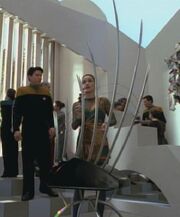
Harry Kim and Eudana behind a Sikarian atmospheric sensor
A few of the crew including Janeway, Paris, Tuvok and Kim beam down and accompany Gath to a marketplace. Kim meets a local named Eudana who is playing what seems to be a musical instrument, but is really a Sikarian atmospheric sensor . She shows him how to use it and he's quite amused. Gath, meanwhile, stays with Janeway and leads her to a fabric vendor. He's obviously taken an especially strong interest in Janeway and insists she accept a whole wardrobe made just for her. She politely declines the strong offer and simply considers a scarf . He continues making increasingly uncomfortable forward advances, but Janeway politely expresses a desire to organize other officers to take turns on the planet. He agrees but keeps his hands on her, not letting go until she agrees to attend festivities that evening.
Act Two [ ]
At the evening's festivities, Harry Kim shares a romantic moment with Eudana. He begins telling her about how Voyager became stranded in the Delta Quadrant when Eudana suggests they go some place with more privacy. She pulls Kim onto a platform and transports to a place called Alastria . It is a warm and tropical place with gentle trade winds blowing during a red sunset. Kim is feeling a slight elation when he notices that Sikaris does not have two suns. Eudana explains that they are in fact no longer on Sikaris but that they have actually been transported to another planet 40,000 light years from Sikaris. Realizing that this might mean the crew could make it more than halfway home, Kim wants to go back immediately. He informs Janeway of his instantaneous travel via a transporter that operates on the principle of folding space called a spatial trajector . Excited about real prospects of finally getting home, Janeway proposes to Gath that they allow them to modify the technology in order to transport Voyager closer to home. But Gath informs them that based on their Canon of Laws , sharing this technology would be out of the question as it may get out of control and fall into the wrong hands. Kim and Janeway are very disappointed.
Act Three [ ]
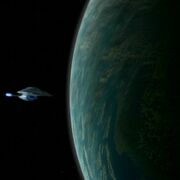
Voyager in orbit of Sikaris
During the staff meeting later on, the crew discuss the possibilities that the trajector presents them, including the chance that it could be used more than once allowing them to make it all the way to the Alpha Quadrant. Tuvok points out that Gath has already said no with nothing to indicate that he could change his mind, making the debate pointless. Janeway listens to the various comments and then points out that, as Starfleet, they have similar restrictions with regard to sharing technology. Janeway remarks with irony that it is the first time they are on the other side of the Prime Directive which prevents them from interfering with alien cultures no matter what kind of a disaster they were facing. Tuvok then says, on the other hand, their refusal might be the prelude to negotiation. Kim then offers the insight of how the Sikarian culture values stories as a measuring device of character and moral value, and proposes the idea of offering the entire ship's library as a bartering token. Janeway approves the idea and plans to run the idea by Gath. Excited, Torres says she'll scan the device in the meantime, but Janeway explicitly forbids this saying they won't violate their laws until she finds them negotiable. Torres is very let down.
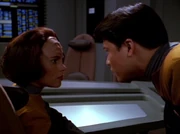
" What's wrong? " " I just hope she gets it . "
Over a slice of pecan pie in her quarters , Janeway moves to negotiating the acquisition of the trajector. At first she promises Gath that they promise to destroy the trajector after they have reached their destination. However, as expected, Gath turns down her offer. Janeway then proposes that the Sikarians use the device to send Voyager itself, without giving up the technology, in return for a full library of the Federation 's finest literature. Gath is immediately enticed and promises to discuss it with the other magistrates within the area, though Janeway tries to read him to see how serious he is.
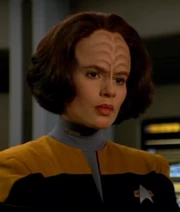
Torres listening to Seska pine for home
In the meantime, Torres is going on with her engineering duties and inspects Voyager 's shock attenuation cylinders . However, seeing Seska is not paying attention, they both get drawn into a theoretical discussion about how the trajector works, anxious about having finally found a real possibility to go home. Joe Carey , overhearing, joins in and they begin theorizing, noting that such spatial folding would leave subspace residue. Detecting a particular neutrino dispersion pattern, the three theorize that if the spatial trajector uses a neutrino bubble to transport objects, the main deflector could be modified to emit phased neutrinos to create a bubble around Voyager .
On the surface, Eudana leads Kim to a secret meeting with Jaret Otel , Gath's aide, who offers to unofficially give them the technology in exchange for the ship's collection of literature. Jaret explains that his people believe rules should be flexible enough to meet the needs of the moment and reveals that he wants to be the provider of the stories to the public in order to gain prestige. Jaret also tells Kim that Gath has no intention of handing over the technology himself.
Ensign Kim returns to the ship intending to report this immediately to Janeway. While he waits in the mess hall, he talks with Paris, Torres and Seska. Paris ultimately recommends letting the captain handle it, and the two leave once Kim is told Janeway can see him. When they go, Seska and Torres briefly discuss stealing the technology. Torres, surprised, asserts that being the higher ranking officer she has responsibilities, but Seska declares that if they were to gain access to the trajector matrix, the use of main engineering would be essential and that Torres had to be on their side. Seska appeals to Torres by mentioning the captain's seemingly being taken by Gath and unwilling to do what's needed. Seska leaves Torres conflicted.
Act Four [ ]
Janeway and Tuvok hear what Kim has to say. Janeway can't help but feel that Jaret is correct when he says that Gath does not intend to help them. She thanks Kim for coming to her with the information before dismissing him, after which she continues discussing the situation with Tuvok. She notes that she's in a unappealing situation; she can either negotiate with a man whom she suspects has his own agenda, or deal with a man who is willing to break the law. Tuvok points out that if they get the technology through Jaret, then it's his laws that are being broken, and not theirs. Janeway would rather not do that, reminding Tuvok that when they started the trip home she told the crew that they would follow Starfleet principles, but, at the same time, she doesn't know if she can tell the crew that her principles are more important than getting the crew home. With that, the two agree that Janeway should deal with Gath for now and explore the chance that he may be willing to help them.
On the planet, Janeway presses the issue once again, asking Gath about the decision of the magistrates. But after Gath's repeated evasion of the subject and ridiculing their desire to go home, Janeway soon realizes Gath's true intentions, which were only to provide the populace with a novelty and avenue of entertainment, without ever having had any real intention of helping them out. Gath then promptly orders Janeway and her crew to leave the planet, accusing them of threatening to infect the 'joyousness of our lives'. Disheartened and insulted, the captain taps her combadge and returns to the ship.
Entering the bridge, Janeway tells Chakotay that shore leave is cancelled and to start beaming the crew back. She tells Tuvok that she knows that Gath never intended to help them, but is nonetheless unwilling to go against Sikaran law by getting the technology from Jaret Otel. Unfortunately, as the crew is scattered all over Sikaris, it's going to take some time to get everyone back onto the ship, so Janeway simply tells Chakotay to do it as quickly as possible before retiring to her ready room.
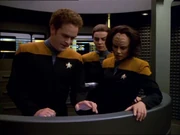
" It's not accepting my security code. "
Back in the mess hall, Torres, Seska, and Carey discuss what's happened. Seska has downloaded the Federation library into isolinear chips , ready to be handed over to Jaret and she and Carey end up getting a reluctant Torres onto their side by discussing their families and the Maquis plight in the Demilitarized Zone . They head immediately to the transporter room, and prepare to beam to the surface only to be frozen out by security protocols. Tuvok suddenly enters, explaining that he changed the subroutines when he attempted to download the library only to find it had already been accessed. The others are confused until Tuvok reveals that he plans to make the exchange with Jaret Otel himself and beams down after telling the shocked officers to prepare the ship for the device.
Act Five [ ]
The final crew members are being beamed up, and Janeway tells Torres to prepare the ship to leave within minutes. Seska is very worried, but then Tuvok returns with the device and hands it over in engineering and asks them not to use it until he has spoken to the captain. Seska begins tests immediately. While doing the tests, the three engineers suddenly discover that they would need an amplifier the size of a planet to make the system work. The Sikarians are able to use the technology because Sikaris itself has a crystalline mantle that focuses and amplifies the trajector field. But Voyager does not possess such an amplifier. Carey notes that if the planet is needed to use the trajector, once Voyager leaves orbit they will lose the ability to traject. They realize that they have to run the trajector right here and now, or else they will not be able to do so later. In order to distract everyone from their actions, Torres – keeping the thrusters offline – prevents the ship from leaving, citing a phase variance.
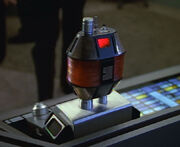
The Spatial trajector is not compatible with Federation technology
After they activate the matrix, a trajector field begins to form. Initiation of the process is successful, but the plasma manifold soon becomes unstable when a bombardment of antineutrinos (designed to act as a catalyst for the space-folding process) results in increasing plasma temperatures that threaten a warp core breach . Reluctant to abort the mission, Seska attempts to compensate for the antineutrinos but fails. Nothing can stop it so Torres is forced to destroy the trajector matrix with a phaser . She realizes with a heavy heart that the use of antineutrinos in the space-folding process would have made any compatibility with Federation technology impossible and that this technology would ultimately never have worked for Voyager . Seska immediately attempts to erase the sensor logs of their testing, but Torres steps in, rejecting a cover-up. She is ready to face the consequences and is actually glad that she has changed enough to want to be responsible. Standing before the captain, she tries to take the blame as the ranking officer, but Tuvok reveals that he was the one who made the exchange with Jaret.
After a serious dressing-down, Janeway lets Torres go, warning her that any further transgression – even a minor one – would lead to the discharge of her field commission. She is, however, shocked about Tuvok having had anything to do with this. He explains that he knew that the captain found herself in a moral dilemma and thus couldn't allow herself to make such a decision. So – fully prepared to accept the entirety of the consequences, alone – he decided for her; to lift the burden off her shoulders. Janeway, clearly touched, tearfully reminds him of their long standing relationship, citing him as her moral compass, trusted officer, and dear friend, upon whom she is dependent. She firmly states that, although deeply appreciative of his sacrifice, she would never have wanted or allowed him to make any such sacrifice for her, and tacitly demands that he never act on his logic behind her back again. Tuvok personally assures her that she can count on him from now on more so than ever, and that he will never disappoint her in that regard. After stating that the error was not in his logic, but in his decision, Tuvok leaves. Janeway's face falls into both of her hands, clearly distraught.
Memorable quotes [ ]
" It's the first time we've been on the other side of the fence. How many times have we been in the position of refusing to interfere when some kind of disaster threatened an alien culture? It's all very well to say we do it on the basis of an enlightened principle. But how does that feel to the aliens? "
" I don't enjoy being judged like this. It's most unsettling, not at all pleasurable. "
" You're hostile, and vicious… you would infect the joyousness of our lives! "
" I will make the exchange with Jaret Otel. "
" I don't have the luxury of throwing you in the brig for the rest of this voyage. I need you. I need every person on this ship. But I want you to know how very deeply you have disappointed me. If there are any further transgressions – even a minor one – you will no longer be an officer on this crew. "
" I don't even know where to start. I want you to explain how you, of all people, could be involved in this. " " It is quite simple, captain. You have made it quite clear, on many occasions, that your highest goal is to get the crew home. But in this instance, your standards would not allow you to violate Sikarian law. Someone had to spare you the ethical dilemma. I was the logical choice. And so I chose to act. "
" You are one of my most valued officers. And you are my friend. It is vital that you understand me here. I need you. But I also need to know that I can count on you. You are my counsel. The one I turn to when I need my moral compass checked. We have forged this relationship for years, and I depend on it. "
" You can use logic to justify almost anything. That's it's power, and it's flaw. "
" My logic was not in error… but I was. "
Background information [ ]
- The title, alluding to the crew's conflict with their own and another society's "prime" rules, is a mathematical term. An integer's prime factors are all the prime numbers by which it can be evenly divided. For example, 44 is 2 x 2 x 11, or 2 2 x 11. Each integer greater than 1 has a unique set of prime factors, a fact known as the "fundamental theorem of arithmetic." All of a number's nonprime factors are products of two or more of its prime factors. [1]
Story and script [ ]
- David R. George III and Eric A. Stillwell 's original story involved the crew of Voyager encountering the race that had dispatched Gary Seven in the Star Trek: The Original Series episode " Assignment: Earth ". That race had boasted transporter technology that could transport individuals over thousands of light-years. According to Stillwell, " David and I speculated what might happen if the Voyager crew happened upon that civilization. What if they had the ability to transport our crew back to Earth, but because of some terrible failure caused by their intervention on another world in the past, they'd adopted their own kind of Prime Directive to avoid any such disasters in the future? This was the essence of our pitch. " [2] George continued, " As we pitched the story to the producers, though, we realized that they did not want such a strong tie to the original series, and so we spontaneously dropped that aspect of the plot. Fortunately, the producers liked enough of the rest of the tale to send us off with a few notes and an invitation to pitch a second draft. Eric and I did so, and that version of the episode sold. " [3] One production staffer who had not liked the TOS tie-in was Executive Producer Michael Piller . He nonetheless bought the pitch because he liked "the fool's gold nature of the story," which he compared to the film The Treasure of Sierre Madre . [4] George noted, " We did not receive an opportunity to pen the script. " [5]
- The scripting of this episode was influenced by the fact that the Sikarians were originally intended to become one of three recurring, antagonistic alien races in Star Trek: Voyager 's first season (the other two being the Kazon and Vidiians ). ( Captains' Logs Supplemental - The Unauthorized Guide to the New Trek Voyages , p. 127)
- The second draft of this episode's script was submitted on 30 November 1994 .
- The episode was still being written on 12 December 1994 . ("A Day in the Life of Ethan Phillips", VOY Season 2 DVD special features)
- Michael Piller found that writing for the pleasure aliens was difficult. He stated, " I just felt nothing seemed to work with the aliens […] What was tricky about it was to flesh out those pleasure seekers so that they were something other than people walking around always talking about pleasure. I don't think people act like that, so I looked for other things, including the idea that stories were very important to them. " ( Captains' Logs Supplemental - The Unauthorized Guide to the New Trek Voyages , p. 142)
- While the episode was evolving, Star Trek: Voyager 's writing staff found that Seska could serve as a valuably mutinous element. " We found her character to be very useful, " Executive Producer Jeri Taylor commented, " because she could be the voice that wanted to take the technology and go home in 'Prime Factors.' " ( Captains' Logs Supplemental - The Unauthorized Guide to the New Trek Voyages , p. 143)
- In this episode's pre-production stage, Tuvok actor Tim Russ raised some reservations about his character's betrayal of Janeway in the episode, so the actor's input became influential to the script. He noted, " We changed about thirty percent of the script just from my input alone. " ( Captains' Logs Supplemental - The Unauthorized Guide to the New Trek Voyages , p. 142) Russ commented further, " I did get a lot of things changed in that script. Janeway's whole speech at the end was much different. It was much more reprimanding and much harsher and, based on their relationship, that would have not been appropriate. " ( Cinefantastique , Vol. 27, No. 4/5, p. 48) Jeri Taylor concurred, " We made some minor modifications that made it possible for Tim to integrate that action into his conception of his character [i.e. Tuvok's betrayal of Janeway] and we shot the film. " ( Captains' Logs Supplemental - The Unauthorized Guide to the New Trek Voyages , p. 142)
- The episode's final draft script was submitted on 13 January 1995 . [6]
Cast and characters [ ]
- Tim Russ regretted not having been able, due to time constraints, to clarify certain points in the episode. He noted, " I would have liked to have changed about another twenty-five percent [more than the thirty percent that was altered]. " He also explained, " I think that the only thing we didn't have enough time for was to get more clarification on the reasons for his motivation. I think there was a basic difference between what I thought and the producers thought in terms of why he did what he did. We could have clarified those reasons more than we did, but there just wasn't enough time to go back and forth on it since we were shooting in a few days. " ( Captains' Logs Supplemental - The Unauthorized Guide to the New Trek Voyages , p. 142) Russ also remarked, " There were some points missing that we should have clarified in that story. The problem is that you're trying to clarify them two days before you shoot them. " ( Cinefantastique , Vol. 27, No. 4/5, p. 48)
- According to Tim Russ, the main point that he wished to clarify was that, although the writers wanted Tuvok's motivation for betraying Janeway to be that it was the only logical thing left for him to do, logic – according to Russ' beliefs – is only a way to do things, not a reason for doing them. Instead, Russ wanted to make clear that the reason Tuvok chose to act against his captain (sacrificing his commission) was to essentially save her from a shipboard mutiny that seemed otherwise probable. ( Captains' Logs Supplemental - The Unauthorized Guide to the New Trek Voyages , p. 142; Cinefantastique , Vol. 27, No. 4/5, p. 48)
- According to comments from Jeri Taylor and Michael Piller, however, their opinions on this debate matched Russ' more than anyone apparently realized. Taylor recalled, " We saw [Tuvok's betrayal] as a noble, heroic act that he would do to spare his captain her personal ethical dilemma and that he would find the logical way to rationalize that. " Michael Piller said, " Someone who thinks logic is the answer to all questions should think again. Logic can lead you the wrong way too. " Furthermore, both Piller and Taylor were under the impression that Tim Russ was outrightly opposed to the idea that, as a Vulcan, Tuvok would ever betray his captain. According to Tim Russ' comments, however, he was either more (by a large extent) or only opposed to the details regarding the execution of this plot point, not its existence in the episode. ( Captains' Logs Supplemental - The Unauthorized Guide to the New Trek Voyages , p. 142)
- At one point during the making of this episode, Jeri Taylor tried to give Tim Russ some advice. " I told Tim that if he is never going to have flaws or make a mistake or take a step that's beyond the Vulcan limit, " she said, " what are we going to do with him? It's a death signature to a character that he cannot push the envelope and that his reach does not exceed his grasp at some time. " ( Captains' Logs Supplemental - The Unauthorized Guide to the New Trek Voyages , p. 142)
- Of Janeway's decision not to make the trade, Tim Russ observed, " I think that Janeway is walking a very fine line in making a decision based on her standards and principles […] It was a very technical reason why she did not want to do it. " Michael Piller thought Janeway's dilemma had extreme resonance. ( Captains' Logs Supplemental - The Unauthorized Guide to the New Trek Voyages , p. 142) For her part, Janeway actress Kate Mulgrew liked the mutinous elements of the episode's story. " I enjoyed that because it touched on so many levels, " Mulgrew said. " Whenever you can reveal Janeway's humanity and the fact that she's a woman, that she's conflicted, that's an episode I enjoy. " ( The Official Star Trek: Voyager Magazine issue 5 , pp. 23 & 24)
- Michael Piller ultimately regretted the casting of Ronald Guttman as Gathorel Labin here. " It was a mistake casting a French actor as an alien villain, " Piller complained. ( Captains' Logs Supplemental - The Unauthorized Guide to the New Trek Voyages , p. 127) Guttman, however, is actually Belgian.
- This is one installment which Kim actor Garrett Wang valued. " 'Prime Factors' was interesting, " he related, " because that's where I came very close to actually having a romance […] so that was kind of fun. " Wang was also pleased that the episode allowed his character to be seen in less harsh light than was commonly used on the bridge set. " In 'Prime Factors,' I got that sunset-type lighting which looks great on anybody, " he reckoned. " And I liked the scene where I'm being approached by one of the pleasure planet people about making a swap between our library and their technology. " ( Starlog #222)
- Robert Picardo ( The Doctor ) does not appear in this episode.
Production and effects [ ]
- While the episode was in production, the producers became slightly worried with the scenes set on Sikaris . Michael Piller recalled, " We got a little concerned with the dailies because the stuff that was happening on the planet, in spite of all our efforts, was tending to look a little too much like that hedonistic Roddenberry -esque society. I was worried that it was going to be sort of off-putting and that people would not get involved with what the real story was […] But when it was done, I thought it was marvelously produced and that part of the story you kind of moved through really quickly. " ( Captains' Logs Supplemental - The Unauthorized Guide to the New Trek Voyages , p. 142)
- The spatial trajector matrix prop was used previously on TNG : " The Dauphin " as Wesley Crusher's superconductor magnet , shown when Wesley encounters Salia for the first time.
Reception [ ]
- The writers were highly satisfied with this episode's teleplay once it was completed. Jeri Taylor remembered, " 'Prime Factors' was a show we were very proud of. " ( Star Trek - Where No One Has Gone Before , p. 215) Michael Piller recalled, " We felt really good about the script when it was done. I think it was one that everybody thought was working. " Piller believed the best parts of the episode were the tense scenes set aboard Voyager . He stated, " The real story […] had to do with our people and the moral dilemma that was happening around the ship […] When you got onto the ship with the dilemmas and decisions, that's when the story grabbed hold. " Despite the difficulties involved in the making of this episode, both Jeri Taylor and Michael Piller remained pleased with the installment. " To my mind, " Taylor remarked, " it's one of the best that we did first season. " ( Captains' Logs Supplemental - The Unauthorized Guide to the New Trek Voyages , p. 142) Likewise, Michael Piller casually admitted, " I liked the episode, by the way. " ( The Official Star Trek: Voyager Magazine issue 4 , p. 9)
- Eric A. Stillwell and David R. George III were proud of how this episode ended up " I think the final version of the episode was true to our original vision, " Stillwell observed. " And it was a defining moment in the relationship between Janeway and Tuvok in the early days of the series, so I was very pleased with it. " [7] George said, " The finished product closely resembled the story we'd developed, a fact borne out by our receiving sole story credit on the episode. As far as the completed project, I was more or less pleased by it. I liked the basic idea of Starfleet officers having the Prime Directive turned around on them. I also thought it important to explore the idea of just what the captain and her crew would be willing to do in order to get home. And finally, I loved setting up the conflict between Captain Janeway and Lieutenant Commander Tuvok. " [8]
- Despite liking the episode in general, Michael Piller ultimately thought it was unsuccessful at capturing the potential of the Sikarians. He explained, " I was very disappointed with how this alien race turned out […] I think the idea of an alien race seeking new pleasures wherever they go, and they can be extraordinarily dangerous in the pursuit of that pleasure, is a great idea. I just don't think we realized our goals. " ( Captains' Logs Supplemental - The Unauthorized Guide to the New Trek Voyages , p. 127) Piller also commented, " The pleasure planet people, the Sikarians, could have been very interesting, but they somehow just didn't turn out that way […] I didn't particularly care for how the aliens came out. The idea of a race and a species that's driven by pleasure as a motivating force is a fascinating thing to look at [though]. " ( The Official Star Trek: Voyager Magazine issue 4 , p. 9)
- This episode achieved a Nielsen rating of 7.3 million homes, and an 11% share. [9] (X)
- This was the first Voyager episode that was viewed by British author David A. McIntee (who, years later, became an author of official Star Trek fiction). He saw the episode prior to Voyager 's premiere in Britain. ( Delta Quadrant , p. 34) In his unauthorized reference book Delta Quadrant (p. 35), McIntee scores the episode 5 out of 10.
- Cinefantastique gave the episode 3 out of 4 stars. ( Cinefantastique , Vol. 27, No. 4/5, p. 48)
- In their unofficial reference book Trek Navigator: The Ultimate Guide to the Entire Trek Saga (p. 181), co-writer Mark A. Altman rates this episode 3 out of 4 stars (defined as "good") while fellow co-writer Edward Gross gives the outing 2 and a half out of 4 stars (defined as "average").
- In Star Trek Magazine 's retrospective "Ultimate Guide", the magazine gave this episode 3 out of 5 Starfleet-style arrowhead insignia. ( Star Trek Magazine issue 164 , p. 30)
- The writing of this installment was nominated for a Sci Fi Universe Award . [10]
- One aspect of viewer reaction to this episode that Tim Russ became aware of was the response to Tuvok's decision to betray Janeway. " People were very surprised that he made it, " Russ stated. ( Star Trek Monthly issue 33 , p. 28)
- Years after having worked as science consultant on Star Trek: Voyager , André Bormanis cited this episode as one of his favorites from the series, noting, " I thought 'Prime Factors' was a terrific story. " [11]
- Due to their disappointment with the Sikarians, Voyager 's team of writer-producers ultimately discarded their initial plans to make those aliens recurring antagonists. Regarding the concept of the pleasure-seekers, Michael Piller noted, " It didn't come off interesting enough to bring them back. " ( The Official Star Trek: Voyager Magazine issue 4 , p. 9)
Continuity [ ]
- Tim Russ cited the character of Valeris as an example of a Vulcan who, like Tuvok in this episode, makes a choice to betray orders. ( Captains' Logs Supplemental - The Unauthorized Guide to the New Trek Voyages , p. 142) However, Russ also characterized the decision that Tuvok makes as "entirely un-Vulcan." ( Star Trek Monthly issue 33 , p. 28)
- Tim Russ believed this episode was contradicted by two episodes that were produced later in Voyager 's first season, " Learning Curve " and " Twisted " (the latter of which was held back for inclusion in the second season ). Shortly after completing work on "Twisted", Russ explained, " Clearly, in 'Prime Factors' [Tuvok] directly violated protocols up and down the line. Then two episodes later [meaning in 'Learning Curve'] you have him talking about how stern he is about protocols? […] There's [also] a line in an episode we just finished, 'I've always respected the Captain's decisions.' And that line was difficult to say when, in fact, we know he again violated protocols by taking matters into his own hands. " ( Cinefantastique , Vol. 27, No. 4/5, p. 61)
- Given that Tuvok's rank insignia changes from lieutenant commander to lieutenant after this episode, it is speculated that he was demoted for his actions here. However, it is likely that it was only a costuming mistake since he is referred to as simply "lieutenant" off and on during this and earlier episodes.
- The Sikarian spacial trajector represents the second time besides the series premiere (after " Eye of the Needle ") that the Voyager crew is presented with the possibility of returning home much faster than by conventional warp travel. In this case, the technology offers a significant shortcut but is found to be unusable.
- According to the stardates, the events of the 24th century portion of Star Trek Generations take place shortly before this episode and conclude just before the next one .
Video and DVD releases [ ]
- UK VHS release (two-episode tapes, CIC Video ): Volume 1.5, catalog number VHR 4005, 11 September 1995
- As part of the VOY Season 1 DVD collection
Links and references [ ]
Starring [ ].
- Kate Mulgrew as Captain Kathryn Janeway
Also starring [ ]
- Robert Beltran as Commander Chakotay
- Roxann Biggs-Dawson as Lieutenant B'Elanna Torres
- Jennifer Lien as Kes
- Robert Duncan McNeill as Lieutenant Tom Paris
- Ethan Phillips as Neelix
- Robert Picardo as The Doctor
- Tim Russ as Lieutenant Tuvok
- Garrett Wang as Ensign Harry Kim
Guest Stars [ ]
- Ronald Guttman as Gathorel Labin
- Yvonne Suhor as Eudana
- Andrew Hill Newman as Jaret Otel
- Martha Hackett as Seska
- Josh Clark as Carey
Uncredited co-stars [ ]
- Derek Anthony as operations ensign
- Kimberly Auslander as command ensign
- K. Baily as Sikarian
- Michael Beebe as Murphy
- C. Bender as sciences crewman
- Jasmin Bischoff as operations officer
- J.T. Botka as Sikarian
- Allan Bragg as Sikarian
- M. Carter as Sikarian
- Shawn Cash as Sikarian
- R. Chacon as Sikarian
- Lauren Chang as Sikarian
- Elisha Choice as Sikarian
- Kenneth David Ebling as command officer
- Tarik Ergin as Ayala
- Pablo Espinosa as operations officer
- Norman Gibbs as operations officer
- Sue Henley as Brooks
- Kerry Hoyt as Fitzpatrick
- Stan Ivar as Mark Johnson (photo)
- J. Iroldi as Sikarian
- Jeff Jensen as Sikarian
- Julie Jiang as operations lieutenant junior grade
- Martee La Comette as Sikarian
- Nora Leonhardt as operations officer
- Dawn Lovett as Sikarian
- E. McKee as Sikarian
- Lynn Meneses as Sikarian
- B. Miller as Sikarian
- D. Mills as Sikarian
- Jordan Monheim as sciences officer
- Trina Mortley as sciences officer
- Louis Ortiz as Culhane
- Elizabeth Pengson as Sikarian
- Rob Plaza as operations officer
- Sye Pop as Sikarian
- Jerry Quinn as command officer
- Regina Richardson as operations officer
- S. Sanders as command officer
- Richard Sarstedt as William McKenzie
- Daunette Saunders as operations officer
- Geoffrey Smart as Sikarian
- Liz Smollins as Sikarian
- Jennifer Somers as sciences ensign
- Simon Stotler as operations ensign
- Warren Tabata as Sikarian
- John Tampoya as Kashimuro Nozawa
- Piper Taylor as operations officer
- S. Valentino as Sikarian
- Jeff Witzke as operations officer
Stand-ins [ ]
- Jasmin Bischoff – stand-in for Martha Hackett
- Sue Henley – stand-in for Kate Mulgrew
- Cy Kennedy – stand-in for Robert Beltran
- Susan Lewis – stand-in for Roxann Biggs-Dawson
- Lorine Mendell – stand-in for Martha Hackett
- Lemuel Perry – stand-in for Tim Russ
- Jerry Quinn – stand-in for Robert Duncan McNeill
- Ron – stand-in for Josh Clark
- Richard Sarstedt – stand-in for Ronald Guttman
- Jennifer Somers – stand-in for Jennifer Lien and Yvonne Suhor
- Simon Stotler – stand-in for Ethan Phillips
- John Tampoya – stand-in for Garrett Wang
- Unknown actor – stand-in for Andrew Hill Newman
References [ ]
47 ; 2370 ; ability ; Alastria ; Alastria system ; Alastrian twin suns ; antineutrino ; apron ; atmospheric sensor ; bearing ; brig ; Canon of Laws ; Caretaker's array ; Cardassian ; Carey's sons ; Carey's wife ; court martial ; culpability ; dawn zephyr ; Dedestris ; Delaney sisters ; Delaney, Jenny ; Delta Quadrant ; Demilitarized Zone ; distress call ; dozen ; dress ; erosene winds ; ethical dilemma ; ethical grounds ; euphoria ; Federation ; Federation space ; folded-space transporter ; food service ; gondola ; hemisphere ; holodeck ; isolinear chip ; Kelvin ; kiss ; kph ; literature ; logic ; magistrate ; mantle ; microscope ; Milky Way Galaxy ; Mollie ; neutrino ; neutrino bubble ; neutrino imaging scan ; Nivoch ; non-linear resonance ; novelty ; orbit ; order of magnitude ; painting ; pecan pie ; phase variance ; phonograph ; plasma conduit ; plasma manifold ; precept ; Prime Directive ; quantum analysis ; quartz ; scarf ; sculpture ; security subroutine ; senior officer ; sensor log ; Seska's brother ; shock attenuation cylinder ; shore leave ; Sikaris ; Sikaris sun ; Sikaris system ; Sikarian ; Sikarian vessel ; spatial trajector ; statue ; subspace residue ; temperature ; theodolite ; thruster ; trajector matrix ; transportation device ; Venice ; wardrobe ; yellow alert
External links [ ]
- " Prime Factors " at Memory Beta , the wiki for licensed Star Trek works
- " Prime Factors " at Wikipedia
- "Prime Factors" at StarTrek.com
- " Prime Factors " at MissionLogPodcast.com , a Roddenberry Star Trek podcast
- " Prime Factors " at the Internet Movie Database
- 2 ISS Enterprise (NCC-1701)
- The Inventory
One of Star Trek: Voyager 's First Truly Great Moments Is a Fascinating Glimpse at What Might Have Been
A lot of voyager 's first season explores how the crew will get back home, but one early episode explores the dramatic potential in a surprisingly tragic way..
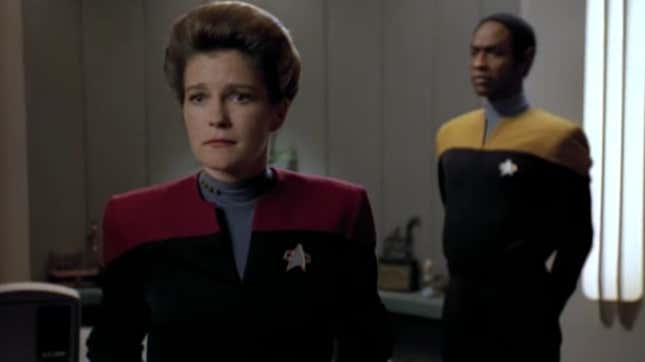
I’ve found myself, even in this impending flood of more new Star Trek than ever, returning to Voyager recently. No matter how many times I’ve seen the show in its entirety, it still surprises me just how much of its first season immediately dives into the well of the titular ship’s crew seemingly finding a way to solve the show’s entire premise: a sudden way to warp the 70,000 lightyear distance that plonked Voyager in the Delta Quadrant and get back home now, instead of in 70 years’ time.
Related Content
It’s kind of bold for the show to, not just once, but repeatedly, dangle this unsolvable idea that Voyager can’t and won’t do just a handful of episodes in. You’re doomed to the inevitability of watching the crew optimistically work toward trying this H ail M ary attempt to get home, knowing it’s not going to pan out. It makes for a weird 40-odd minutes of TV to experience, and Voyager asks you to do this multiple times in season one, some times in quick succession. One such example of this kind of episode however, “Prime Factors,” brushes up against that dread inevitability in a pretty fascinating way.

The episode—only the ninth in the season—largely deals with Voyager encountering a highly advanced, pleasure-driven society known as the Sikarians. The crew soon discover that the Sikarians have highly advanced space-folding teleportation technology that lets them travel upwards of 40,000 light years in an instant , which could help shave generations off Voyager ’s long way home. When the Sikarians’ strict policy of not sharing their technology with outsiders puts a stop to that hope pretty quickly, the rest of “Prime Factors” becomes an interesting Star Trek twist on the morality play, asking which officers among the bridge crew might be willing to push back against the idea of being on the receiving end of another society’s equivalent to Starfleet’s most valued rule: the Prime Directive, the principle that prevents the Federation from intervening with a less-technologically advanced society.
At first, the ethical division is drawn along the unsurprising lines between Starfleet members of Voyagers crew, and the ex-Maquis—the guerrilla resistance fighter group rebelling against the Cardiassian empire’s encroachment on Federation border colonies introduced in Deep Space Nine —who were forced to join in the series’ pilot. Of course the prim-and-proper rule followers like Captain Janeway want to follow protocol, as much as it hurts them to have an opportunity to ease their voyage home dangled out of reach. Of course, the rebellious former dissidents, like B’Elanna Torres and Seska, want to surreptitiously work around Sikarian rules to get access to the technology that could get them back to the Alpha Quadrant faster. But pretty quickly “Prime Factors” complicates things, when the underhanded deal Torres and her allies in the Engineering department make with a Sikarian black market trader finds an unlikely supporter in Voyager ’s security chief Tuvok.
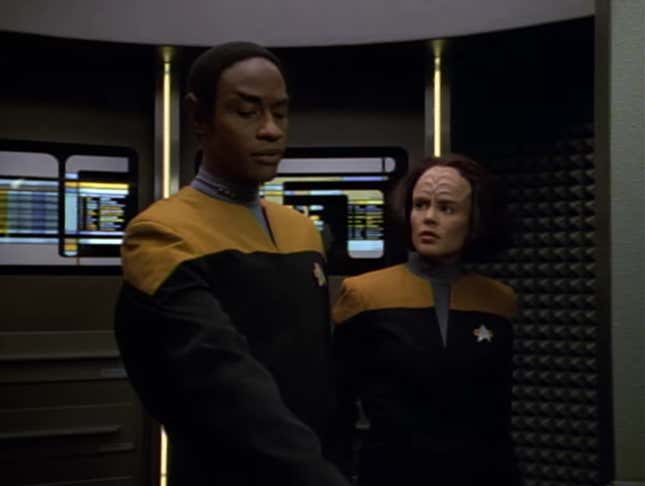
Naturally though, this is still one of those inevitable conclusion episodes. Tuvok gets Torres the trajector technology without Captain Janeway’s authority, but it can never work, because this is season one of Voyager and the show isn’t just going to end or severely shorten its lifespan just nine episodes in. The trajector not only doesn’t work, its unexpected incompatibility with Starfleet systems renders it useless, nearly taking Voyager with it, and leaving Janeway incredibly pissed , leading to “Prime Factors” concluding with a truly remarkable final scene. Instead of ending on the frustration that the tech failed and Voyager ’s crew has to move on in their journey home, it ends on something far darker. Janeway calls Torres and Tuvok in to take the fall when she discovers they went behind her back.
At first, she’s full of fury, berating B’Elanna for letting her down. But when it comes to addressing Tuvok’s role in the duplicity, things turn softer, and sadder. Even this early on in Voyager one of the key things we know about the primary crew is that Janeway and Tuvok are incredibly close friends, the echoes of relationships like Kirk and Spock, Sisko and Dax, or Picard and Riker. So instead, the anger gives way to heartbreak, as the barriers between Janeway’s professional face as a c aptain and her personal side break down, giving way to one friend deeply hurt and mourning the actions of another. The episode doesn’t end with things resolved either, but with Janeway and Tuvok on unsure ground—willing to move ahead with reprimand as c aptain and t actical o fficer, but unwilling to question what this betrayal of confidence actually means for their friendship.
It’s fascinating , but also frustrating. Voyager ’s structure as a highly episodic series means that this incredible denouement starts and ends with conclusion of “Prime Factors.” The damage to Tuvok and Janeway’s friendship is immediately dropped. As heartbreaking as it is to see in the moment—anchored in a brilliant performance by Kate Mulgrew and Tim Russ, one achingly emotional and the other constrained by Vulcan logic—their conversation has no consequence, logistically or emotionally. Voyager simply moves on, the events of the episode never to be brought up again. But you cannot help but wonder what might have been if the show was not so solely confined by Trek ’s episodic bread and butter, if all these relationships and their ups and downs were allowed to sit and linger beyond the events of particular episodes. Especially a show like Voyager , where personal and structural events should have a much larger feeling of consequence, considering the ship is all the crew have stranded far from the rest of the Federation.
Alas, that can only ever be a thought experiment—as inevitably doomed to fail as the Voyager crew’s chances of finding a way home are this early on in the show. And yet, it’s a moment that still hits all these years later, one of the first true signs of Voyager ’s dramatic potential... even if it ultimately doesn’t quite live up to all of it.
Wondering where our RSS feed went? You can pick the new up one here .
- Show Spoilers
- Night Vision
- Sticky Header
- Highlight Links

Follow TV Tropes
http://tvtropes.org/pmwiki/pmwiki.php/Recap/StarTrekVoyagerS1E9PrimeFactors
Recap / Star Trek Voyager S 1 E 9 "Prime Factors"
Edit locked.

The Sikarians prove good to their word and lavish Voyager's crew with food, recreation, and gifts. Gath takes a shine to Janeway and offers her outfits of fine fabrics. Janeway is reluctant to impose, but Gath insists that giving pleasure to others gives his people pleasure. Meanwhile, Kim meets a cute local engineer named Eudana who is held rapt by the plot of " Caregiver ." She wants him to tell more stories and uses a trajector to beam them both to a place called Alastria for privacy. Kim realizes that they're not on Sikaris anymore. They're actually 40,000 light years away!
Kim rushes back to Janeway, telling her that the Sikarians have technology that folds space, allowing them to transport themselves up to 40,000 light years away. However, Gath tells them that it is illegal for the Sikarians to share their technology out of fear that it could be used for immoral purposes. After years of standing behind the Prime Directive to refuse to help less-advanced civilizations, Janeway admits it feels bad to be on the other side for once. However, Tuvok suggests that Gath's refusal might just be a prelude to negotiations. Janeway resolves to butter him up and try again. Remembering Eudana's thirst for stories, Kim suggests offering the ship's database of literature as payment for the trajector. Torres volunteers to study the trajector herself as a fall-back, but Janeway doesn't want to risk offending the Sikarians during negotiations.
Offering pecan pie and centuries of new stories, Janeway again asks for the trajector, promising to destroy it once they return home. Gath again refuses. Then Janeway suggests that the Sikarians themselves beam Voyager 40,000 light years closer to home, since that would still shave decades off their trip. Gath agrees to bring the offer to his government.
On the planet, Eudana takes Kim to a clandestine meeting with another Sikarian who says he'll smuggle the trajector to Kim in payment for the stories. Kim takes the backdoor offer to Janeway, who is caught in a moral bind. She can't bear to break her principles by acquiring the trajector illegally, but she also can't bear to tell the crew that they will remain stranded because of her scruples. Tuvok advises her to stand firm and at least see how the offer to Gath pans out. But when Janeway returns to Gath, she realizes that he's giving her the runaround and never had any intention of agreeing to her deal. Janeway orders all crew to return to the ship and depart as soon as possible.
This episode provides examples of:
- Absence Makes the Heart Go Yonder : Janeway and Harry Kim enjoy the local attractions, despite having love interests back in the Alpha Quadrant.
- A House Divided : With the prospect of getting home in one fell swoop, not only ex-Maquis rebels B'Elanna and Seska but even Starfleet officers Carey and Tuvok end up covertly opposing their captain.
- Alien Arts Are Appreciated : Stories are of great value in Sikarian society, so Janeway offers to trade Voyager's entire library in exchange for some help getting home. When the respective leaders' negotiations break down, their underlings do it anyway behind their backs.
- Alien Non-Interference Clause : The Prime Directive is discussed and is indeed a source of conflict, together with the Sikarians' own version of the law.
- Alien Sky : Harry realises he's been transported to another star system when he sees the Binary Suns .
- All for Nothing : Sikaris technology was never compatible with the Federation's.
- Almost Kiss : It's not enough that Harry turns down his chance for some alien nookie, he interrupts Janeway and Gath as well!
- Bait-and-Switch : Tuvok has caught the conspirators red-handed as they're about to beam down to the planet with Voyager's library. Then Tuvok states he will make the exchange himself.
- Be Careful What You Wish For : The episode begins with Janeway voicing her concern about whether the Starfleet and Maquis crews will be able to get along and fully integrate. The group of officers who collude to steal the Sikarians' technology in defiance of Janeway's orders are an exact 50/50 split of Starfleet and Maquis.
- Beneath the Mask : Janeway's voice cracks when giving Tuvok her What the Hell, Hero? speech.
- Call-Back : Harry entertains Eudana with the events of "Caretaker".
- The Chains of Commanding : Should Janeway bribe a local official to get around the Prime Directive? Is getting her crew home more important than the principles she's sworn to uphold?
- Chick Magnet : Harry Kim! One of the Delaney sisters allegedly knocked him off a holodeck gondola into the water while trying to make out with him, and he quickly attracts the attention of Eudana.
- The Conscience : Janeway says to Tuvok, "You are my counsel, the one I turn to when I need my moral compass checked."
- Continuity Nod : Chakotay points out there have been past occasions when Starfleet personnel have chosen to ignore the Prime Directive on strong ethical grounds.
- Deliberate Values Dissonance : Gath is The Hedonist , always ready to move on to the next source of pleasure. He doesn't understand why Janeway would want something more permanent, or the crew's overall desire to return to the Alpha Quadrant.
- Disappointed in You : Janeway to B'Elanna and Tuvok.
- Downer Ending : Voyager fails to use the trajector to make any progress, and Janeway is badly shaken by the disobedience of her officers.
- Early-Installment Weirdness : Janeway putting up with Gath's overtly physical attentions, given her later Celibate Hero status.
- Eating the Eye Candy : Seska busts B'Elanna checking out Ensign Murphy.
- Failure Is the Only Option : Come on, it wouldn't be Voyager if things were this easy for them!
- Fake-Out Make-Out : Jaret Otel has Eudana bring Harry to him for their secret meeting, as it doesn't look strange that she would take him off somewhere private.
- False Reassurance : When Janeway calls out Gath on lying about wanting to help, he protests it's not true. After all, he's done everything to convince them to stay on his planet.
- Faster-Than-Light Travel : The Sikarians' teleporter works by folding space. Harry theorizes that it could be jury rigged into a Jump Drive.
- Flashy Teleportation : The Sikarians' spatial projector, which has a greyish mist about it when in use. Voyager hopes to use for a Lightspeed Leapfrog .
- Food as Bribe : Janeway softens up Gath with pecan pie before pitching the idea of a trade for their technology.
- French Jerk : Gath has a conspicuous French accent, which aligns with American stereotypes of the French being libertines and also passive-aggressive jerks. The showrunners later regretted indulging in the trope.
- Funny Background Event : During the Cold Open , a female member of the crew in a blue shirt can be seen behind Harry, clearly having a laugh at the story of his and Tom's exploits with the Delaney sisters.
- Gossipy Hens : The episode opens with B'Elanna and Seska discussing who's dating who.
- Jaret is open about how the trade he is offering is unsanctioned and to his own advantage but makes good points about why it should be accepted and seems somewhat sympathetic to their goals, while only asking for books from another planet.
- Janeway forbids Torres from trying to reverse-engineer the trajector behind the Sikarians' backs, opting instead to deal honestly with Gath and not risk offending him.
- Janeway opts to deal honorably with the Sikarians rather than break their laws and steal the trajector, even if it means remaining stranded in the Delta Quadrant.
- Seska wants to blame the malfunction on the warp core breach, but B'Elanna insists on coming clean to Captain Janeway, accepting responsibility on behalf of all the conspirators.
- Hope Spot : The Space Folding Matrix seems like it'll work, but the presence of anti-neutrinos means that it never could be compatible with Federation systems. B'Elanna was forced to destroy it when it couldn't be removed from its interface.
- Humanoid Aliens : Sikarians look exactly like humans. Their only embellishment is halo-like rings strung through their hair.
- I Did What I Had to Do : Tuvok tries to use this justification for attempting to get Voyager home by using alien technology behind Janeway's back.
- La Résistance : The first episode since "Parallax" which deals with the Maquis element on the Voyager crew.
- Letting Her Hair Down : Janeway lets some strands drop out of her Bun of Steel during a late night with Gath.
- As Jaret Otel is a Sikarian, accepting his offer would not be a violation of the Prime Directive, though it is immoral.
- Janeway bans B'Elanna from snooping, but this doesn't stop B'Elanna, Seska, and Carey from discussing 'in theory' how the Sikarian technology might work.
- The Main Characters Do Everything : When Janeway is called to the bridge, Kim, Paris, and Torres are all in the mess hall with her. When she arrives at the bridge, all our main characters have resumed their posts, apparently relieving whatever redshirts were on that shift at the moment.
- Mistaken for Exhibit : Harry sees Eudana playing what he assumes is a Harp of Femininity . It's actually an atmospheric sensor that works via sound. That doesn't bother Harry much, as he immediately deduces how it works and they start bonding over that instead .
- Mundane Utility : Eudana uses the spatial projector to hop halfway across the galaxy for a Make-Out Point .
- Nice Girl : Eudana, who responds nicely to Kim's flirting and introduces him to Jaret to buy the space folding matrix when her government won't give it to the Federation.
- No Sense of Personal Space : Gath repeatedly touches up Janeway, who reacts with surprise at first but warms up to it.
- Not Distracted by the Sexy : Choosing to immediately tell Janeway about the stationary transporter that wasn't going anywhere instead of giving thirty minutes to the hot woman who was pawing at his chest says so much about how Harry Kim would be written over the next seven years.
- Not so Dire : Voyager answers a Distress Call from the Sikarians, only there's no emergency. They actually want to help Voyager, having heard they're lost in the Delta Quadrant and need cheering up!
- Obstructive Bureaucrat : Gath is eventually revealed to be one, doing nothing to appeal for the Federation to use the technology and preferring for them to be there and under his influence.
- Planet of Hats : The Sikarians are another highly advanced post-scarcity utopia who live only to give and experience pleasure. The downside is that they get bored with things and people after the novelty wears off and are always looking for something new.
- Pleasure Planet : Sikaris is home to an advanced society who have nothing better to do than pursue pleasure. Their laws give them strict morals, but that doesn't prevent them from being realistically jaded and shallow.
- Plug 'n' Play Technology : At first literally played straight— the Sikarian device plugs into a console in Engineering despite being acquired only moments before, so the crew wouldn't have had time to construct an interface. However the trope is ultimately averted.
- Puppy-Dog Eyes : Janeway lamenting The Chains of Commanding to Tuvok in the privacy of her Ready Room. One can't help wondering if the Vulcan is Not So Stoic , given his subsequent actions.
- "The Reason You Suck" Speech : Janeway to Gath on the shallow values of the Sikarians, who responds by throwing them off the planet , as they're not fun anymore.
- Rest-and-Resupply Stop : Unfortunately their rest is cut short, not by an external enemy but by their own actions.
- Rules Lawyer : Gath refuses to hand over their transportation technology because of their laws, even when the virtuous Voyager crew just wants to get home. Janeway suggests a compromise in which they transport Voyager as far as possible without handing over the technology. Gath makes encouraging sounds, but Janeway eventually realises he has no intention of helping them.
- Also Eudana introducing Kim to someone who can sell him the necessary technology.
- On a paradise planet, populated by a species with technology far in advance of the Federation, stories are the only thing of value that Voyager has.
- From the Sikarian point of view, the Voyager crew's desire to get home. Why would they want to do that when there's a paradise they can settle down on right here?
- Shoot the Dog : Tuvok conspires to get the Space Folding Matrix illicitly, because Janeway's moral code prohibits her from taking action when the Sikarian Magistrate has prohibited use of their technology.
- B'Elanna has a bad feeling about this.
- The MacGuffin involves folding space.
- Straw Vulcan Janeway: You can use logic to justify anything. That's its power, and its flaw. From now on, bring your logic to me. Don't act on it behind my back. Tuvok: You have my word. My logic was not in error, but I was.
- Janeway is pleased that the Maquis and Starfleet crews appear to be getting along. Then they cooperate to disobey her orders behind her back.
- This Cannot Be! : Janeway is utterly shattered at Tuvok's betrayal; it's not clear from this how their friendship will be affected.
- Two Roads Before You : See The Chains of Commanding .
- Unfinished, Untested, Used Anyway : The conspirators realise the alien technology only works near Sikaris, so have to use it right away before Janeway goes to warp. Unusually for this trope, it goes horribly wrong and nearly destroys Voyager .
- Walk-In Chime-In : Carey revealing that he wants in on the conspiracy. Seska: Look at that neutrino dispersion pattern. Could that be a result of space folding? Torres: Maybe. If the device creates a neutrino bubble around whatever's being trajectored. Carey: [offscreen] If that's the case, we'd need a bubble big enough for the ship. ( Oh, Crap! Reaction Shot from Seska and Torres) Don't worry, Lieutenant. I'm with you on this one. After all, it doesn't hurt to theorise.
- What Happened to the Mouse? : Eudana disappears after introducing Kim to Jaret.
- What the Hell, Hero? : A devastating one is given at the very end by Janeway to Tuvok.
- Star Trek Voyager S 1 E 8 "Emanations"
- Recap/Star Trek: Voyager
- Star Trek: Voyager S1 E10: "State of Flux"
Important Links
- Action Adventure
- Commercials
- Crime & Punishment
- Professional Wrestling
- Speculative Fiction
- Sports Story
- Animation (Western)
- Music And Sound Effects
- Print Media
- Sequential Art
- Tabletop Games
- Applied Phlebotinum
- Characterization
- Characters As Device
- Narrative Devices
- British Telly
- The Contributors
- Creator Speak
- Derivative Works
- Laws And Formulas
- Show Business
- Split Personality
- Truth And Lies
- Truth In Television
- Fate And Prophecy
- Edit Reasons
- Isolated Pages
- Images List
- Recent Videos
- Crowner Activity
- Un-typed Pages
- Recent Page Type Changes
- Trope Entry
- Character Sheet
- Playing With
- Creating New Redirects
- Cross Wicking
- Tips for Editing
- Text Formatting Rules
- Handling Spoilers
- Administrivia
- Trope Repair Shop
- Image Pickin'
Advertisement:
- Movies & TV Shows
- Most Popular
- Leaving Soon
- Documentary
- Browse Channels
Featured Channels
- Always Funny
- History & Science
- Sci-Fi & Action
- Chills & Thrills
- Nature & Travel
- Black Entertainment
- Kids & Family
- International
- Gaming & Anime
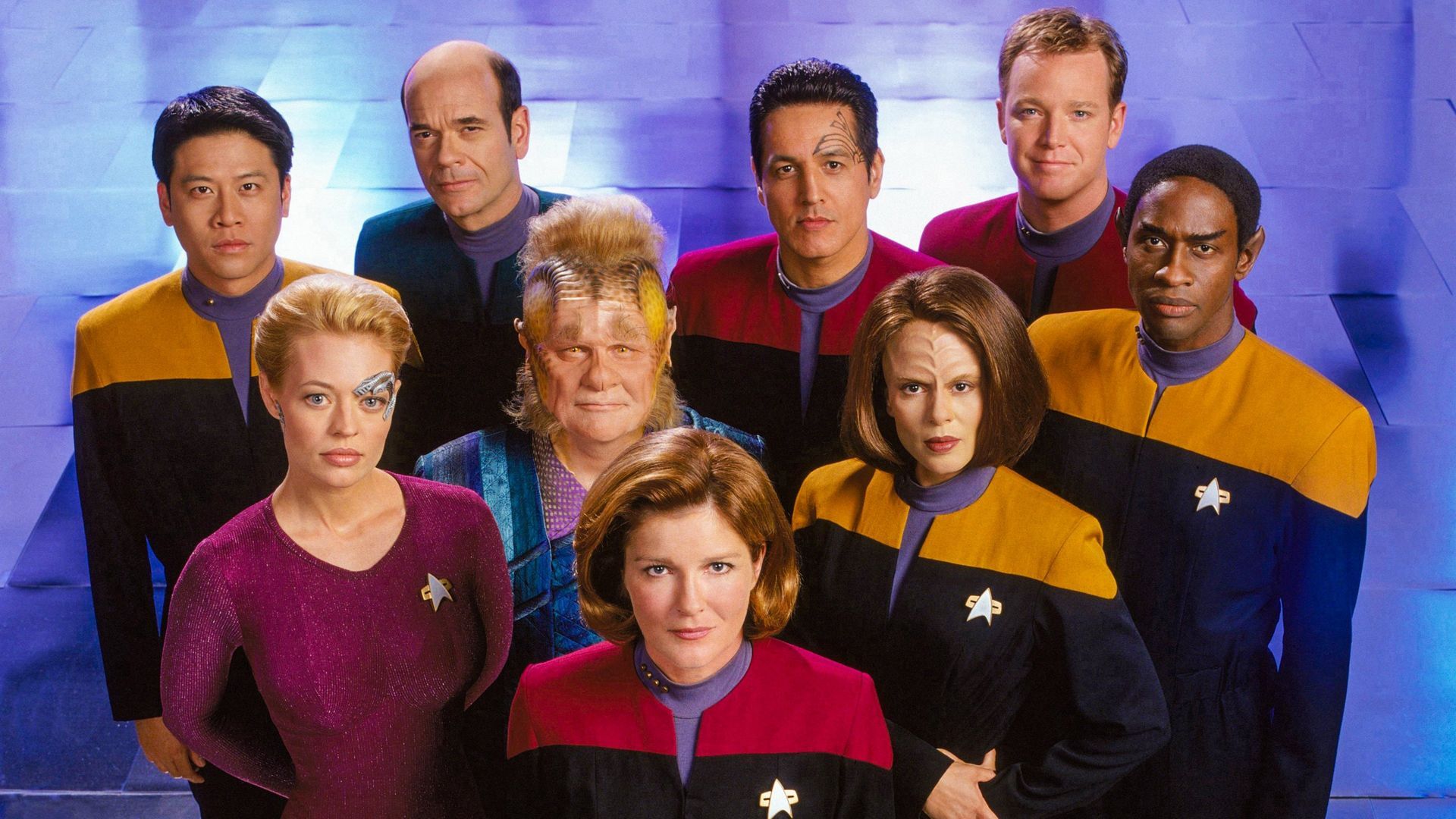
Star Trek: Voyager
Prime factors, watch on these services.
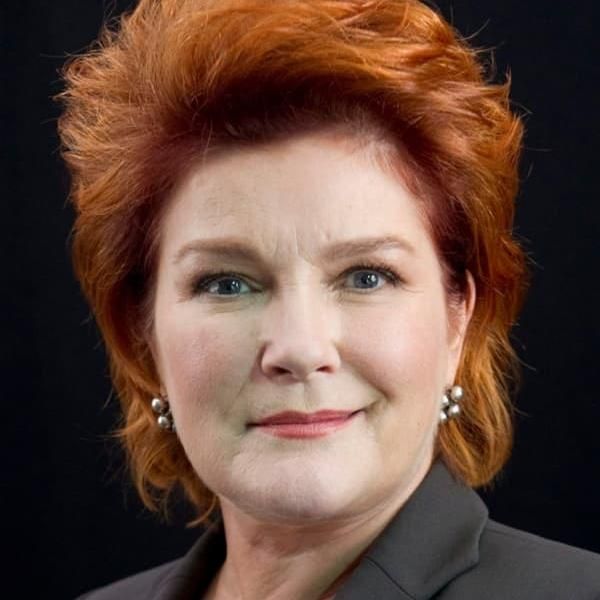
Take Plex everywhere
Star Trek: Voyager (TV Series)
Prime factors (1995).
- User Reviews
- The Sikaris girl who gets aroused by Harry Kims nerdy technical talk about her musical weather pattern device.
- The planet 40,000 light years away with wind that makes you feel Euphoria?!? Where do I sign up?
- Apparently 'stories' are sold in back allies like crack cocaine is sold in the common era. I wonder what stories are considered the most valued?
- T'Vok brings back a classic 'needs of the many' moment with his decision to sacrifice his career/oath to Starfleet to get the crew back and save Janeway from either making the decision to betray the principles or adhering to the principles and crushing the crews hopes. T'Vok ---- you are a great wing man. He even doubles down on being so damn selfless by taking the head for the whole attempt to use the tragector matrix despite telling Torres to not use it.
- We get a great 'disappointed mom' talk from Janeway. It always hurts way worse to have a disappointed parent than having an angry parent. 4
- Janeway tells Tuvok to get it together and be the wise principled logic fueled Vulcan she needs on this ship. I feel love/uncertainty/fright within her speech. Mulgrew really is under appreciated for her acting ability in my opinion --- Love ya Kate.
Awards | FAQ | User Ratings | External Reviews | Metacritic Reviews
- User Ratings
- External Reviews
- Metacritic Reviews
- Full Cast and Crew
- Release Dates
- Official Sites
- Company Credits
- Filming & Production
- Technical Specs
- Plot Summary
- Plot Keywords
- Parents Guide
Did You Know?
- Crazy Credits
- Alternate Versions
- Connections
- Soundtracks
Photo & Video
- Photo Gallery
- Trailers and Videos
Related Items
- External Sites
Related lists from IMDb users

Recently Viewed

- Web Channels
- Star Trek: Voyager
Prime Factors

An alien leader has the technology that could send the crew 40,000 light years closer to home -- but refuses to share it with them.

Martha Hackett
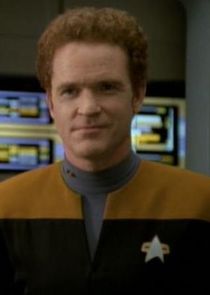
Ronald Guttman
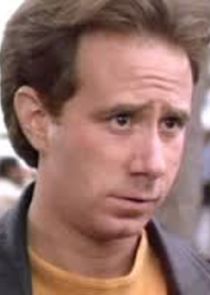
Andrew Hill Newman

Yvonne Suhor
Cast appearances.
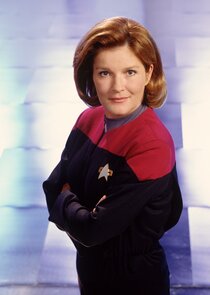
Kate Mulgrew
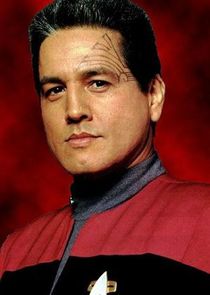
Robert Beltran
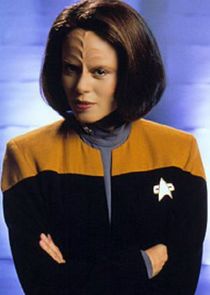
Roxann Dawson
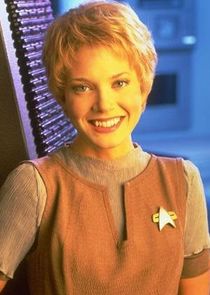
Jennifer Lien
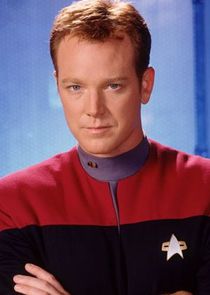
Robert Duncan McNeill

Ethan Phillips
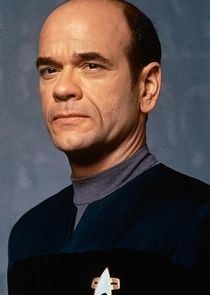
Robert Picardo
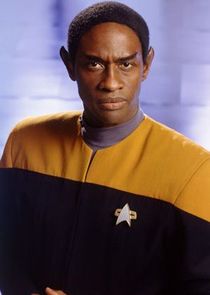
Garrett Wang
Episode discussion.
No comments yet. Be the first!
- Buy the Book…
- Reviews Hub

the m0vie blog

Following Us
- Adding Our RSS Feed to Your Gmail
- Following our Feed in Internet Explorer
- Millennium (Reviews)
- Star Trek: Deep Space Nine (Reviews)
- Star Trek: Enterprise (Reviews)
- Star Trek: The Next Generation (Reviews)
- Star Trek: The Original Series (Reviews)
- Star Trek: Voyager (Reviews)
- The X-Files (Reviews)
- X-Files Fandom Poll Form
Check out the Archives


Awards & Nominations

Star Trek: Voyager – Prime Factors (Review)
This September and October, we’re taking a look at the jam-packed 1994 to 1995 season of Star Trek , including Star Trek: Deep Space Nine and Star Trek: Voyager . Check back daily for the latest review.
Prime Factors has some great ideas, but blunders awkwardly in the execution. In that respect, it genuinely feels like a first season episode of a new show in the same way that The Cloud did – there’s a sense that the series is trying to expand its own comfort zone in a way that offers potential for future storytelling opportunities. Prime Factors might make a few pretty serious missteps along the way, and often seems a little too timid to commit to its bolder ideas directly, but at least it feels more ambitious than Time and Again or Ex Post Facto .

Make way for Janeway…
Continuity is a funny thing. It’s easy to point to continuity as common narrative threads running through a series, a sense that “a leads to b leads to c” even outside a single unit of story. It conjures up images of long-form storytelling and worldbuilding – a sense that a show inhabits a real world where events have an appreciable impact on what happens going forward. This is one view of continuity, and it’s traditionally the view that leads to criticisms of Star Trek: Voyager for its perceived lack of internal continuity.
And these criticism are perfectly valid. Even in the first season, stories about resource scarcity seem to exist as fringe details on the edge of stand-alone stories like The Cloud , Phage or Emanations . There’s not even a sense that Voyager is consistently looking for the same resources over the first season. In The Cloud , it’s replicator energy; in Phage it’s unrefined dilithium; in Emanations it’s a new element that could help with upkeep and maintenance. There’s no sense that there’s a logical pattern to this, or that this is a single continuous story in any real sense.

Fashioning a new world from whole cloth…
And yet, there are other forms of continuity. These are subtle elements that tend to build up around a show over an extended period of time. Characters who recur, little nods to shared back story. These don’t create a sense that these episodes are individual chapters in a single story, so much as that these are all stories launched from a single starting point. The first season of Voyager works on this sense of continuity a lot more than most people give it credit for. Unfortunately, it’s an approach the show would eschew in later years.
And so Prime Factors works as a great example of this – building on what has already been established and leaving a lot on the table for later episodes to explore. It is based around the idea that Tuvok is the crewmember on Voyager with the closest relationship to Janeway. It features two recurring guest stars, crewmembers who appeared in the show’s second episode – Parallax – as if reinforcing the idea that this is a ship inhabited by just over a hundred people; you’re bound to see many of the same faces.

Wanna hear a funny story?
So, in the context of what came before, Prime Factors is a little exciting. It’s taking ideas and characters from earlier episodes and using them to enrich the story being told. Positioned in the middle of Voyager ‘s first season, it looks quite exciting. Sure, the first season has wasted or ignored a lot of its potential, but Prime Factors would seem to be learning. This is a lot more like what Voyager really should be. The fact that it serves as a companion piece to State of Flux is particularly exciting – it seems like Voyager is pushing itself in the right direction.
It’s not too hard to understand why Prime Factors was greeted with enthusiasm and excitement on initial broadcast. Cinefantastique gave it three stars out of a possible four. Contemporary fan reaction on usenet was pretty positive . Voyager seemed to be following through on its thus-far-unfulfilled promise. However, watching television in real time is a different experience from watching it with the benefit of hindsight.

A world of their own…
There is less excitement and novelty to it – less capacity to be surprised or awed by particular twists or revelations. At the same time, it’s a lot easier to contextualise each episode. It’s possible to place each episode in its proper place, to appreciate how it shaped what would follow, and what it means in the larger arc of the show. Some episodes benefit greatly from this retrospective appraisal; others suffer. In hindsight, Prime Factors seems like a false dawn.
However, most of the steps taken by Prime Factors and State of Flux are subsequently undermined and ignored. After all, despite the sense of community developing on the show, it’s worth noting that Lieutenant Ayala is the only character outside the lead cast to appear in both Caretaker and Endgame ; and he doesn’t have any lines in either. Even the recurring guest stars from the first and second seasons feel somewhat utilitarian in application – they aren’t developed organically so much as introduced with an intended purpose and discarded later.

“Hello, this is Ensign Seska. You’ll definitely be spending the next seventy years with her.”
For example, Lieutenant Peter Durst is introduced in Cathexis so his death in Faces has weight; Michael Jonas appears in Alliances so he can recur through the second season leading up to Investigations ; Seska has been recurring throughout the first season of Voyager so far, but Martha Hackett has confirmed that the production team had the basics of her arc mapped out from pretty close to the beginning of the show.
Even then, Voyager ‘s really stops introducing those recurring crew members after the second season. Seska is pulled one direction and dropped from the recurring cast at the end of the second production season, or the start of the third broadcast season.) Joe Carey ceases to exist in Voyager ‘s present after the events of State of Flux , coming to symbolise Voyager ‘s past, a handy indicator that a given episode involves a time travel or an alternate timeline.
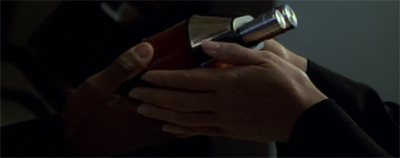
A Prime cause of concern…
With all of this in mind, Prime Factors ultimately seems far more cynical in retrospective. A lot of time and effort is invested in developing Seska as a potentially subversive personality – she’s ready to do whatever it takes to get home, even if that involves lying and mutiny. That’s a pretty great card to have tucked away; something that could undoubtedly come in handy at some point down the line. Unfortunately, the show tidies away that potential as quickly as possible.
(That said, there is a great deal of fun in the way that State of Flux reveals that Seska is blatantly manipulating Torres. Stories about promises made to her brother and talking about the vows made to protect the De-Militarised Zone seem cynical enough in context, but are brutal in light of subsequent revelations. Even with that in mind, the beautiful pay-off to those interactions doesn’t feel like a fair trade for all the storytelling opportunity lost by the resolution to State of Flux .)

Inconsistent characterisation is totally illogical.
There are other ways subsequent plot developments undermine Prime Factors . As Tim Russ noted in an interview with Cinefantastique , some of the later episodes in the same season tend to pretend that Prime Factors simply doesn’t exist:
Russ gives as an example a scene in Learning Curve, in which Tuvok forms a kind of Starfleet Academy night school for the Maquis crew members. In the story, Tuvok claims to be a stickler for protocols, yet, as Russ explained, “Clearly, in Prime Factors he directly violated protocols up and down the line. Then two episodes later, you have him talking about how stern he is about protocols? This is the kind of thing I’m talking about. There’s a line in an episode we just finished, ‘I’ve always respected the Captain’s decisions.’ And that line was difficult to say when, in fact, we know he again violated protocols by taking matters into his own hands. The bottom line is: it is very difficult to believe a character and stay with him if you are going to consistently jump the ship in terms of what he’s laid down.”
This would become a common complaint from the cast working on Voyager – that there was no real sense of development, no real acknowledgement of the past actions of certain characters and how that should affect their future decision-making process.

“You just be glad Picard isn’t here. He’d make you feel SO ashamed.”
Indeed, even the conclusion to Prime Factors feels like a bit of a wash. Janeway has just discovered a mutiny on her ship, led by her best friend and most trusted confidante. And, yet, nobody involved in the cover-up is punished. Both Torres and Tuvok receive a firm tongue-lashing from Janeway, but there’s a sense that her fury and righteousness is ultimately impotent. It amounts to little more than “don’t do it again!”
While Star Trek isn’t really built to support episodes with heavier long-term conclusions, it still feels like a cop-out. When Sisko came down softly on O’Brien’s mutinous conduct at the end of Captive Pursuit , it was made clear that this was a passive endorsement of O’Brien’s conduct. At least Sisko’s criticism of Worf in Change of Heart gave the impression of having consequences. Picard never really had to deal with a moment like this in Star Trek: The Next Generation , but even his brutal criticism of Wesley in The First Duty has more bite than this.

Looks like they found coffee outside that nebula…
Here, Janeway’s dressing down of Tuvok and Torres feels superficial. Coupled with the way that Ex Post Facto completely glosses over Paris’ unprofessional conduct and Phage has Janeway lazily refuse to punish the Vidiians for their crimes, it does a lot to undermine Janeway as a character – making a case that she is more bark than bite, prone to over-the-top melodrama without a willingness to back it up.
Part of what’s interesting about Prime Factors is the fact that – despite this ending – it’s very clearly written with a view to strengthening Janeway’s character. Janeway is the first female lead in a Star Trek series, just as Sisko was the first non-white lead character. It’s strange how much difficulty Voyager had with writing Janeway as a woman when Deep Space Nine had no real difficulty with Sisko as an African American.

Ah, the Picard school of leadership…
To be fair, Star Trek has always done better on issues of race than on issues of gender. Uhura’s position on the bridge of the Enterprise was notably primarily due to her ethnicity – it was great to have an African American in such a prominent position. Uhura’s position is a lot less flattering viewed through a feminist lens – Nichelle Nichols has conceded that Uhura was essentially the Enterprise’s receptionist . While episodes like Court Martial and The Ultimate Computer presented African Americans in positions of authority, The Turnabout Intruder made it clear that there were no women starship captains.
While Code of Honour was an embarrassingly racist moment from the first season of The Next Generation , the series had issues with its characterisation of female characters through to its final season, to the point where Beverly Crusher’s big story of the final season ( Sub Rosa ) involves her having sex with a candle. While Deep Space Nine did better, it’s still notable that their later mirror universe episodes were preoccupied with the notion that “girls kissing girls are hot” and produced episodes like Profit and Lace .
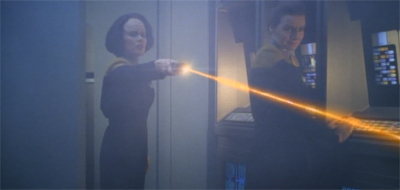
This is how we do things in Torres’ Engineering…
All of this is a very roundabout way of suggesting that Janeway was probably always going to be tough character for Star Trek to write, and that the show needed to be very careful with her. As far as feminism has come in recent decades, there are still any number of pre-conceptions that exist and are casually perpetuated. Women in positions of authority are particularly likely to be stereotyped. In fact, observers are likely to use the behaviour of women in authority to reinforce and validate their own sexist beliefs .
Indeed, no matter how a woman in authority acts, there’s likely to be a stereotype to account for it . Concerned about those under her? She’s a “mother.” Aggressive? She’s a “ball-buster.” Intuitive? “Overly emotional.” Logical? “Ice queen.” It is very easy to fall into the trap of playing into sexist stereotypes because there are so damn many of them. One could easily justify the various zig-zags taken by the Voyager writing staff in characterising as attempts to avoid various pit falls. However, swerving to avoid one stereotype means you wind up hitting another. It’s a lose-lose situation.

“Hm. It’s edible. I can’t serve that, Captain.”
It was a problem of which producer Jeri Taylor – one of the driving forces behind Janeway as a character – was acutely aware. As she explained on Voyager: Inside the New Adventure :
One of the… dangers in choosing a woman with a show that has a high male demographic is that the men in the audience would not accept her as a commander, so we knew that we needed to find someone who would be convincing, who would have a sense of authority, who had a sense of power and presence that you would believe a crew of starship people would follow anywhere.
It is worth noting that a considerable amount of complaints and criticisms of Janeway as a character came from a very vocal minority of sexist Star Trek fans .

It’s nice to see Kim still misses Libby so much…
Prime Factors seems mindful of that, and seems written to play with the idea. Janeway enjoys a potentially flirtatious relationship with Gathorel Labin, but she’s never unprofessional. She’s polite and flattered and enthusiastic, but it’s hard to imagine Sisko or Archer (or Kirk) being any less so. The gentleman is polite (at first) and generous; this is a respite from a cruel quadrant. And yet, because Janeway is a woman, it’s very easy to play into sexist stereotypes and read the relationship a particular way.
Seska does as much, trying to sew dissent among the crew. “The Captain is so infatuated with the Sikarian Magistrate she can’t think straight,” she contends. We’ve seen little evidence of this. The moment Janeway realises what Labin wants, she orders Voyager to depart orbit and continue on its quest for home. She isn’t conflicted by any “infatuation” with Labin, and instead acts in the best interests of the crew.

The weekly crew gossip session is always great fun.
(This admittedly seems like an extreme reaction in context. Is Sikarian altruism any less valid because it’s ultimately selfish? There’s a school of thought that might suggest most altruism is about making yourself feel better . While that may be debateable, is the good deed that you do for somebody else undermined by the fact that you take pleasure in it? Surely that’s the best possible outcome – literally everybody is happy.)
Seska is very clearly just playing up a sexist stereotype to undermine Janeway – pretty much everything she says in Prime Factors is exposed as manipulation by the events of State of Flux . The double-standard being applied to Janeway is stressed by the fact that Harry Kim is able to run off with a female Sikarian without anybody gossiping or rumour-mongering. Janeway may be involved with a man back home (just as Kim is involved with a woman), but she doesn’t sneak off to another planet to get some privacy.

Engineering a mutiny…
Drawing attention to this double-standard is a very clever piece of writing, particularly because it seems to be quite astute. It’s interesting that one of the first thoughts that crossed Anthony De Longhis’ mind when cast as Maj Cullah was that “he may be romancing her a bit.” Of course, that didn’t end up being the case, but it speaks to a subtle double standard about female leaders. One suspects that the Voyager writers were mindful of this. While Kirk, Picard and Sisko all got romantic subplots in their first two seasons, Janeway has to wait until the fifth season episode Counterpoint before she gets a romantic involvement.
That said, the Voyager writers do deserve some measure of credit for their work with Janeway. The character ends up hazily defined and internally inconsistent, but – barring the occasional exception like Fair Haven – the show avoids quite the most obvious sexist clichés. The problems affecting Janeway’s characterisation are similar to those which plagued Scott Bakula’s Jonathan Archer during the first two years of Star Trek: Enterprise – a sense that the writers had no idea who Janeway was meant to be .

“You know, just once I’d like to visit a pleasure planet that is actually a pleasure.”
That said, Voyager does have problems with some of its other female characters. Introducing a catsuit-wearing Seven of Nine, dressing Jeri Ryan in outfits so tight that she would get faint on set , was a massive set-back to the show. That said, it wasn’t as if the objectification of Seven of Nine was Voyager ‘s first misstep. The relationship between Neelix and Kes is downright creepy at times. Seska’s character development during the second season reduced her to little more than a jilted lover rather than a credible antagonist.
So it’s interesting to see Voyager wrestling with this sort of character issue in the first season – stressing the double-standard that exists for Janeway as a character. Even though the episode’s finalé undermines Janeway’s credibility significantly, it has absolutely nothing to do with her gender. Pre-empting this sort of attitude and criticism is a very shrewd bit of meta-commentary. One of the best aspects of Prime Factors is the way that engages in that sort of discussion of the show.
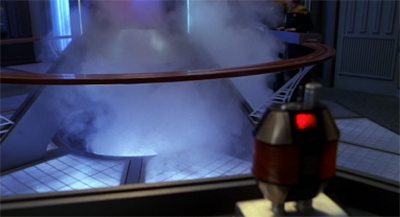
Burning away Janeway’s faith in them…
The Sikarians were apparently originally considered as recurring antagonists, along with the Vidiians or the Kazon. Ultimately, that didn’t pan out. While there are a lot of problems with the portrayal of the Sikarians in Prime Factors , there are also some vaguely interesting ideas. For example, they seem to represent a nice analogue to the classic Ulysses myth – Voyager’s encounter with a paradise trying to convince them to stay can’t help but recall the island of lotus eaters from Homer’s classic poem.
That feels appropriate, as we discover that Sikarian culture is based around the value of story and mythology. “Stories are an important part of their culture,” Harry explains. “They seem to provide more than entertainment. They’re kind of a measuring rod of values and beliefs.” In a way, then, they serve as a fairly effective commentary on the franchise itself – the ideal of stories that carry big ideas and transcend mere entertainment; stories that mean something.

Something to chew over…
After all, certain factions of the Sikarians are willing to trade for their technology. They want the stories. They want Voyager ‘s stories. It feels like a very clever piece of writing – after all, getting home would ultimately be the end of Voyager ‘s story. Getting the Sikarian technology and using it to magic themselves home would rob them of their stories – the stories that they might have, if they remain; the seven years that lie ahead.
Indeed, Janeway and Labin’s discussion about the future seems like a discussion about Voyager as a show. Stopping on Sikaria would mean an end to the story; getting home would mean an end to the story. Ultimately, Janeway decides that the ship and the show needs to push ahead under its own power, rejecting immediate gratification in favour of “the reward of relationships that endure and grow deeper with the passing of time.” In other words, a slow burn and organic development. Ignoring the fact that Voyager never manages to fully realise all that potential, it’s a nice sentiment.

You can’t go home again…
In keeping with the episode’s meta-commentary, there’s a subtext to the conversation that seems to cast Lubin as an entitled Star Trek fan, possibly the type of Star Trek fan the production staff found themselves dealing with on a regular basis. Lubin wants stories and immediate gratification; he’s willing to tolerate and flatter and indulge Voyager for as long as it entertains him. However, he is just as quick to turn against it – like the vocal fans unsatisfied with the first season so far.
As such, Janeway’s response to Labin feels like an opportunity for Voyager to directly address those fans. “That’s all you really care about, isn’t it?” Janeway asks. “Your pleasure. All your hospitality, your graciousness, it was never about giving us pleasure. It’s all been to gratify yourselves. We’re nothing more than the latest novelty.” For a show having trouble courting its fanbase during the first season, it’s an understandable sentiment.

Well, at least they’ll have a story to tell…
That said, despite the fun inherent in the premise, the Sikarians do feel a little awkward. Most obviously, they don’t seem alien. As with Time and Again , it doesn’t make the Delta Quadrant seem unusual or alien. These are people in silly outfits. It doesn’t help that the whole “pleasure planet” idea seems like an awkward throwback to the Gene Roddenberry school of science-fiction. Prime Factors doesn’t turn Sikaria into a sex paradise, but it does feel a bit too much like a generic outer-space holiday resort.
These impressions are not helped by the decision to cast Ronald Guttman as Labin. In Captains’ Logs Supplemental – The Unauthorized Guide to the New Trek Voyages , Michael Piller incorrectly identifies the Belgian actor as French, but that underscores the point. Labin seems like a generic European stereotype – a seductive and sensuous hedonist who doesn’t seem to do any work. Not only does this reduce his credibility as a potential antagonist for the show, it also makes him feel like a cartoon character.

“Quite a mess (hall) you’ve made of this one, Tuvok…”
It is worth noting that writers Eric A. Sitwell and David R. George III originally imagined the Sikarians quite differently :
Being true to our Trekkie origins, the pitch for Prime Factors sprang from a TOS reference in the episode Assignment Earth, when Gary Seven is sent by aliens from the other side of the universe to intervene in the course of human events. Scotty makes some reference to a transporter beam coming from some far away part of the galaxy so distant that the Enterprise sensors couldn’t reach that far. So David and I speculated what might happen if the Voyager crew happened upon that civilization. What if they had the ability to transport our crew back to Earth, but because of some terrible failure caused by their intervention on another world in the past, they’d adopted their own kind of Prime Directive to avoid any such disasters in the future? This was the essence of our pitch. Again, Michael Piller didn’t like the so-called gimmicks from TOS, but he liked what he considered the fool’s gold nature of the story. He likened it to the film The Treasure of Sierra Madre and hired us to go write the story. Even though David and I didn’t get to write the screenplay, I think the final version of the episode was true to our original vision. And it was a defining moment in the relationship between Janeway and Tuvok in the early days of the series, so I was very pleased with it. The writing of the episode was also nominated for a Sci-Fi Universe Award.
While the premise is so fannish that it could easily have aired during Enterprise ‘s fourth season, Sitwell and George did come up with a nice hook that made its way into the final episode.

Mutiny is the only logical outcome…
The idea of turning the Prime Directive on its head is fantastic. It does a lot to help the uncomfortable implications from Caretaker that Voyager would be the most advanced race in the Delta Quadrant – dealing primarily with primitive civilisations. Having our characters on the flip side of the Prime Directive is a wonderful narrative inversion, even if it’s crowded out by everything else going on in the episode.
Similarly, the idea of the mutiny is a great idea, the sense that not everybody on the ship will agree with Janeway. After all, what’s the point of integrating the Maquis if they will just fall into Starfleet group think? Unfortunately, Prime Factors isn’t quite able to deliver on this premise. It really just feels like Seska making trouble, rather than a legitimate sense of crew unease. As the leader of the Maquis, it really feels like Chakotay should be more involved here than he is. While the idea of having Tuvok betray Janeway makes for good drama, the plot doesn’t do enough to explain it.

Heavy lies the head that wears the bun…
It is worth noting that Tuvok’s betrayal is a rather cynical portrayal of Vulcans, suggesting that Voyager buys into the same logic as Star Trek VI: The Undiscovered Country . Far from a rational ideal, Prime Factors seems to present logic as a philosophy easily corrupted – falling into the trap of suggesting that human “feeling” is objectively the right way to view the universe. “You can use logic to justify almost anything,” Janeway explains. “That’s it’s power, and it’s flaw.” She stops short of suggesting that one must follow their gut.
Still, despite these (sizeable) flaws, Prime Factors does feel like it is trying to develop and expand what Voyager can be. It stumbles along the way, but it is a first season episode of a Star Trek spin-off. It is supposed to stumble. That’s how it gets better later on. The strengths of The Next Generation and Deep Space were built on the foundations laid by pretty troubled first seasons. A lot of the first season of Voyager has been content to be a redux of The Next Generation . Prime Factors is trying to be something different. Even knowing how that turns out, it’s hard to complain too loudly.
You might be interested in our other reviews from the first season of Star Trek: Voyager :
- Time and Again
- Eye of the Needle
- Ex Post Facto
- Prime Factors
- State of Flux
Share this:
Filed under: Voyager | Tagged: delta quadrant , feminism , first season , janeway , Prime Directive , prime factors , sikarians , star trek: voyager , voyager |
10 Responses
The parody Janeway in reviews – the one who murders people and is a bipolar mess – is fun, but that sort of thing is not unique to Star Trek. Very few TV shows have well-written, consistent characters who evolve naturally throughout (to it’s credit, DS9 maintained an even keel with its cast). I’ve never disliked Janeway as others seem to. Putting a woman in the captain’s chair was, in itself, a feminist act. Even if she was later sidelined in favor of Seven (something which reportedly offended Mulgrew on a political level, if you believe what Wang says), I think female viewers were savvy enough to see past that.
Television is a clumsy business, and you have to expect inconsistencies. Doubly so with Star Trek, a merchandising giant which is micro-managed to a stifling degree; big corporations aren’t known for taking unneeded risks, and the result is you have a cast of posable action figures instead of characters (Have you seen that YouTube interview of Bill Mumy where he tells of being raked over the coals for adding ONE syllable to his dialog without clearing it with upstairs?). I can certainty see the logic in Janeway’s heavy-handed decisions over the years, or even Tuvok’s pragmatism here. The problem is that the writers didn’t care to draw a logical line between what the characters did and why they did it. Just writing in a simple scene of motivation proved too much for the writers to handle. The result the senior staff does whatever the episode requires them to, with little explanation, and then they’re back to the default setting by the end. Action figures instead of characters.
Yep. I think Voyager suffers largely as a product of its time. Janeway is no more erratic or uneven a character than Kirk was, but I think audiences were expecting more at this point in time. I think that Voyager was quite complacent in that regard, producing late eighties and early nineties television into the middle and later part of the decade. I think that hurt the show.
Also, I suspect the competing voices in the writers’ room hurt Janeway’s characterisation quite a bit. Jeri Taylor was more interested in a feminine nurturing Janeway than Michael Piller or Brannon Braga; I think Piller wanted a bit of a rough edge to her, whereas Braga wanted a conflicted and driven Janeway.
The result is that her characterisation bounces around quite a bit, but it feels you only really get that incredible divergence that fans and critics love to talk about if you hop between the seasons. And it’s not growth, because there’s no in-universe accounting for it. Season One and Season Two Janeway is radically different from Season Three and Season Four Janeway, who is radically different from Final Seasons Janeway.
Whereas Sisko is simply hazy and out of focus until around The Maquis, and then he’s just Sisko; and Picard is always Patrick Stewart.
I watched this tonight for the first time, and I loved it. I loved putting the shoe on the other foot and having the Federation people be the primitives who couldn’t be given advanced toys because they might hurt something. I thought that was a brilliant idea, and I wish the episode had done a little more with it, but doing it at all was cool.
I liked it that B’Elenna has gone from being a hothead to someone who has to confess to the captain when she screws up; it’s nice to see that she’s grown.
And I loved the whole thing with Tuvok. The idea that he’s Janeway’s moral counselor makes sense to me, coming as I do from a TOS-only background. Spock’s wonderful ethics and incredible goodness is part of why I love him so, and it was nice to see that this new Vulcan was also considered a moral resource. And then, when he goes against Janeway’s orders and all but SAYS that it’s out of love for her (I don’t mean romantic love), well, that was quite a moment. Vulcans won’t SAY “I love you,” but “I compromised my principles in an effort to make you happy” sounds like a declaration of love to me. 🙂
Obviously, I don’t have the huge context for all of this that you do. But I love moral dilemmas, I love character development and character relationships, and I love exploration of new cultures. This episode was heavy on all of those factors, and I found it highly enjoyable. It doesn’t reach the level of genius that “Amok Time” or “Journey to Babel” or “The Devil in the Dark” did — I’m not saying it’s one of the greats — but it felt like Star Trek to me. 😉
I think that the duology of Prime Factors and State of Flux are a highlight of the first season of Voyager. (I’m also a big fan of Projections, but that was produced in the first season and aired in the second.) They feel like episodes that really embrace the central premise of Voyager. Michael Piller had a very tough time managing Voyager, in a large part because he left and then came back, but I do think he had a strong vision of the show. (I also quite like his script for The Cloud.)
I am a big fan of Tuvok. I think Tim Russ does wonderful work in a role that is perhaps a little under-written at times. But the second and fifth seasons have two of my favourite Tuvok-centric Voyager epidodes.
“Heavy lies the head that wears the bun”. Especially if you’re Yubaba from Spirited Away.
I found this an interesting episode for a number of reasons. For one, we have a nice alien of the week that was willing to invite Voyager in as guests and provide supplies without it being some kind of trap. If this were TNG or DS9, the aliens would be trying to drain the fluids from their bodies, or kidnap the crew. It was almost unsettling that there was no evil plan all along (which Chakotay was genre savvy enough to suspect one). I’m not even sure it’s right to say there is even an antagonist in this episode.
That said, it does seem like Janeway just way over reacts when she learned that the aliens just wanted to trade for some literature. In probably the best trade deal Janeway will ever encounter, copies of cultural literature for advanced technology, and she just outright rejects it even though that literature is one of the least harmless resources Voyager possesses, and the aliens have already shown good faith by providing assistance to them. Compare this deal, with the one Picard had to put up with in the episode you mentioned “Code of Honor”, where the aliens in that case the aliens were willing to provide a vaccine in exchange for the right of abducting a member of Picard’s crew, raping her and forcing her into a life of bondage, all the while Picard just had to smile and politely (and patiently) ask for Tasha back. Janeway should be grateful she hit the jackpot, this was the deal of a lifetime and she for some reason got all uppity about it over the fact that the aliens weren’t 100.0% altruistic and pure. Maybe the shock of being stranded in the Delta Quadrant hadn’t set in yet, because in just 2 years, she’ll form a tenuous alliance with the Borg to get what she wants.
Yep. Janeway is a little… selective in the principles she choose to apply. But she does seem to intensely believe in those principles for the forty minutes that she has chosen to apply that particular set.
I took this episode, among other things, as an exploration of whether or not Janeway has the character needed to get her people home. We’ve seen her struggle a bit with the assignment being over her head (as it would almost anyone), and with how her somewhat elitist tendencies aren’t suited to the situation. This seems like a natural extension of this thread.
She never seems particularly comfortable with the Sikarian’s flirtation, first seeing it as a compromise in order not to jeopardize the crew’s shore leave, then as a tool to stave off making what she sees as a bigger moral compromise.
She can tolerate Torres’ insubordination but Tuvok’s betrayal hits her hard as she sees it as a confirmation from her closest friend that she doesn’t have the right judgment. He positions himself as the Batman to her Gordon in order to give her an out, which would have been an interesting path for the show to go down, but alas. Maybe he became a stickler for protocol to compensate for this lol
Ha! Maybe. It would be fascinating to have seen Tuvok and Janeway get more development. It’s odd that Paris (of all people) becomes Tuvok’s most constant springboard outside of Neelix.
How did the Kazon not conquer the Sikarians?
Leave a comment Cancel reply
This site uses Akismet to reduce spam. Learn how your comment data is processed .
Recent Posts
- 373. Pirates of the Caribbean: The Curse of the Black Pearl (#225)
- 371. Poor Things (#246)
- 370. Dune: Part Two (#12)
- 369. Memento (#57)
- 368. Monty Python and the Holy Grail (#154)
Recently tweeted…
- "I Simply Am Not There": The Existential Horror of Eighties Excess in "American Psycho"...
- Star Trek: Deep Space Nine - Necessary Evil (Review)
- X-Men: Fatal Attractions (Review/Retrospective)
- Star Trek: Deep Space Nine (Reviews)
Available at…

Blogs Well Worth Your Time
- 1001 Must See Films
- Andrew at the Movies
- Anomalous Material
- Cut the Crap Movie Reviews
- Encore Entertainment
- Fandango Groovers
- FlixChatter
- Four of Them
- It Rains… You get Wet…
- Jameson Cult Film Blog
- Jar Watches Films
- Let's Go To The Movies
- M. Carter at the Movies
- Marshall and the Movies
- Movie News First
- Musings from a Man Lost in La Mancha
- Never Mind Pop Film
- Paragraph Film Reviews
- Roger Ebert's Journal
- Ross v. Ross
- Scannain.com
- Screenwriter (Donald Clarke, Irish Times)
- Strange Culture
- The Film Cynics
- The Pompous Film Snob
- The Projection Booth
- Things That Don't Suck
- Too Busy Thinking About My Comics
- Undy a Hundy
Film Nerd Resources
- CinemaBlend (News)
- Internet Movie Database
- Rope of Silicon
- The Guardian Film Blog
- James Berardinelli
- Roger Ebert
Email Subscription
Enter your email address to follow this blog and receive notifications of new posts by email.
Email Address:
Sign me up!
Blog at WordPress.com. WP Designer.
- Already have a WordPress.com account? Log in now.
- Subscribe Subscribed
- Copy shortlink
- Report this content
- View post in Reader
- Manage subscriptions
- Collapse this bar
Prime Factors
The crew of Voyager discovers a planet that has the technology to send them more than halfway along their journey home. However, the planet’s inhabitants are more than reluctant to share this technology with Voyager’s crew, as doing so would violate one of the society’s own prime directives.
In this episode of the podcast, Wes and Clay discuss “Prime Factors” and building an episode with distinct plot threads. Plus! The guys chat about masturbatory hedonism, being annoyed by the Prime Directive, and the decision of Tuvok.
- Post author By Wes
- Post date 05/03/2022
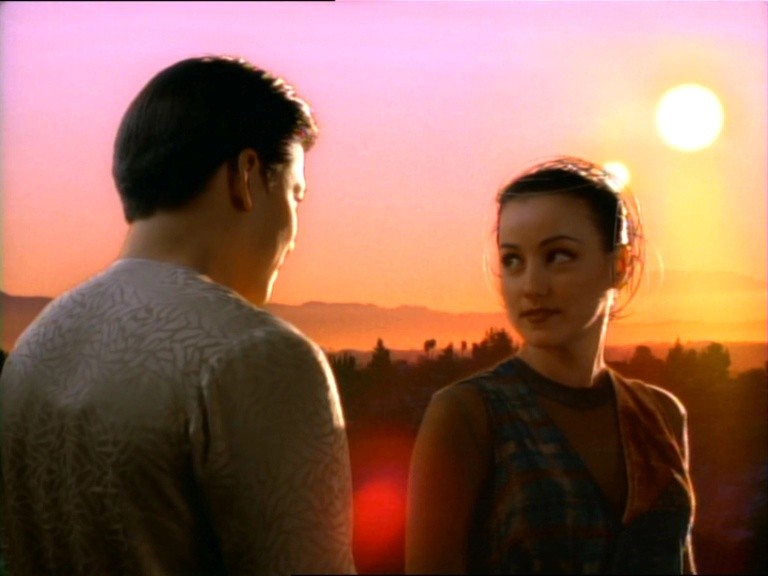
Subscribe: Apple Podcasts | Spotify | RSS | More
When you multiply an episode of Star Trek by the “Prime Factors” of 70,000 light-years, you’re probably going to end up with a decent episode. This week, the crew of the USS Voyager find themselves with a way home – but getting past a mirror version of the Prime Directive might prove impossible. In any case, Harry Kim should have definitely stayed on the orgasm planet for a little bit longer.
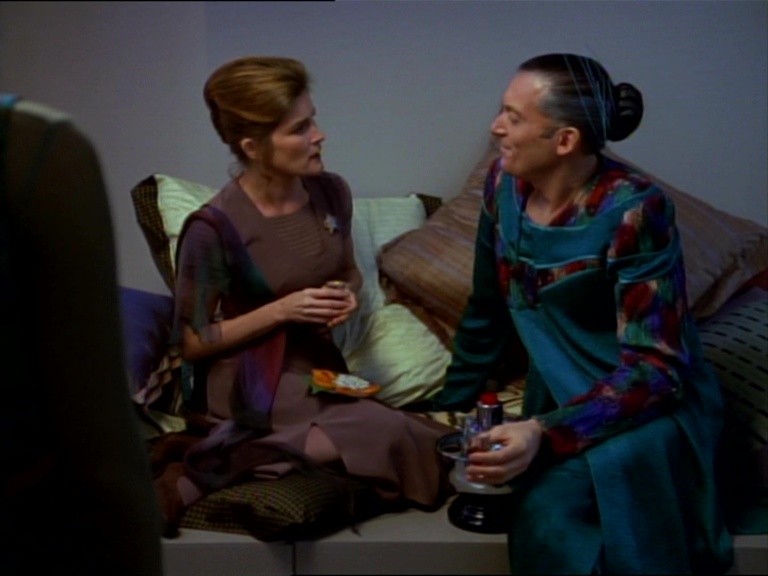
The Wikipedia plot summary for “Prime Factors”:
Voyager encounters a hedonistic and hospitable race known as the Sikarians and is invited to visit their homeworld. Shore leave is organized, and during the visit, Ensign Kim and a Sikarian transport themselves to another planet, Alastria. Kim deduces that the teleporter device—the trajector—has transported them 40,000 light-years.
Captain Janeway is informed, and asks Gath, the leader of the Sikarians, if the technology could be used to transport Voyager further towards the Alpha Quadrant. Gath states that their laws forbid sharing technology. The crew consider how they can bargain for technology, and Kim remembers that stories are valued by the Sikarians. Janeway takes this into account and offers Voyager’ s entire library of literature if the Sikarians will transport Voyager . Gath promises to discuss the offer with the other Sikarian leaders.
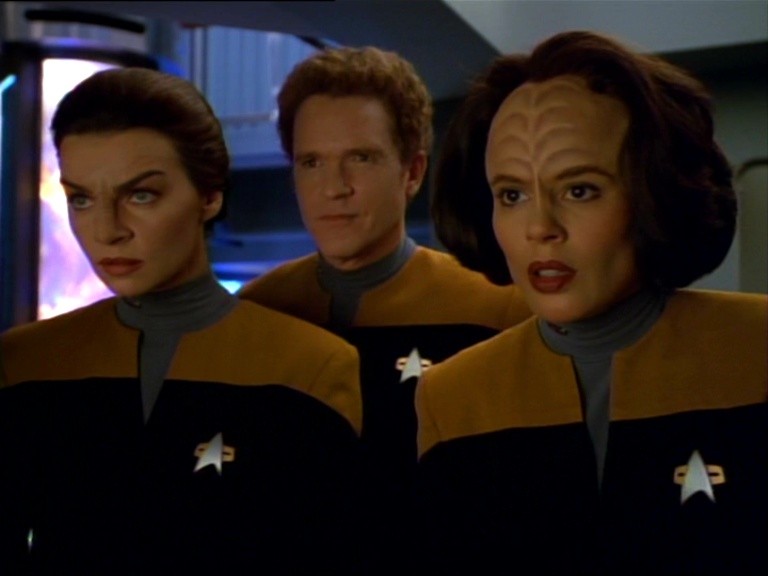
In engineering, Seska , Torres, and Lt. Carey examine the spatial rift caused by the trajector to understand how it works. Later, Kim is approached by a civilian who offers to illegally hand over the technology in exchange for the literature. Janeway is reluctant to authorize an illicit trade, so she beams down to pressure Gath once again, but Gath never intended to accept her offer and orders Voyager to leave. Janeway returns to the ship and orders the recall of all personnel.
Torres, Carey, and Seska have downloaded the library and head to the transporter room. While trying to access the transporter, Tuvok walks in on them — but instead of condemning them, Tuvok beams to the surface and makes the exchange himself. He returns to Voyager with the trajector, instructing the engineering team not to attempt to use it until he has spoken with Janeway. Nevertheless, Seska connects the trajector to a console port in engineering so that they can examine it. They discover that the technology relies on the massive crystalline mantle of the planet as an amplifier, and once they depart, the trajector will be useless. As Voyager is about to depart, Torres and Seska activate the trajector. The field forming around the ship produces anti-neutrinos, which causes the warp core to begin building to a breach. Unable to disengage the trajector from the console, Torres destroys it with a phaser.
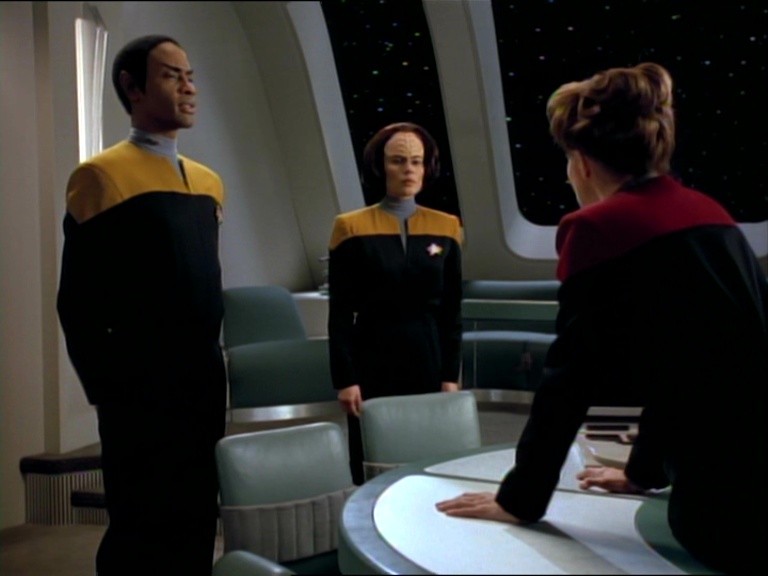
Janeway is shocked to discover Tuvok, her friend and counsel, was the senior officer involved in the conspiracy. She lets Torres off with a stern warning and asks Tuvok to consult her before acting.
Memory Beta, non-canon Star Trek Wiki
A friendly reminder regarding spoilers ! At present the expanded Trek universe is in a period of major upheaval with the continuations of Discovery and Prodigy , the advent of new eras in gaming with the Star Trek Adventures RPG , Star Trek: Infinite and Star Trek Online , as well as other post-57th Anniversary publications such as the ongoing IDW Star Trek comic and spin-off Star Trek: Defiant . Therefore, please be courteous to other users who may not be aware of current developments by using the {{ spoiler }}, {{ spoilers }} OR {{ majorspoiler }} tags when adding new information from sources less than six months old (even if it is minor info). Also, please do not include details in the summary bar when editing pages and do not anticipate making additions relating to sources not yet in release. THANK YOU
Prime Factors
- View history
"Prime Factors" is the tenth episode of Star Trek: Voyager , in the first season of the series.
- 2.1 Characters
- 2.2 Starships and vehicles
- 2.3.1 Shipboard locales
- 2.4 Races and cultures
- 2.5 States and organizations
- 2.6.1 Technology and weapons
- 2.6.2.1 Food and drink
- 2.7 Occupations and titles
- 2.8 Other references
- 3.2.1 Timeline
- 3.3 External link
Summary [ ]
The crew of Voyager encounter the Sikarians , a civilization who possess spatial trajector technology . A faction soon exists within the crew that believe Starfleet 's Prime Directive should be bypassed to acquire the advanced transporter systems that will get them home.
References [ ]
Characters [ ], starships and vehicles [ ], locations [ ], shipboard locales [ ], races and cultures [ ], states and organizations [ ], sciences and classification [ ], technology and weapons [ ], matter and energy [ ], food and drink [ ], occupations and titles [ ], other references [ ], appendices [ ].
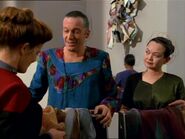
Connections [ ]
Timeline [ ], external link [ ].
- " Prime Factors " article at Memory Alpha , the wiki for canon Star Trek .
- 1 Ferengi Rules of Acquisition
- 2 ISS Enterprise (NCC-1701)

- Movies & TV
- Featured Categories
Image Unavailable

- Sorry, this item is not available in
- Image not available
- To view this video download Flash Player

Star Trek - Voyager, Episode 10: Prime Factors VHS
- VHS Tape from $1.00

Editorial Reviews
Not surprisingly, the actor who had the most trouble with this episode was Tim Russ, who objected to Tuvok's mutinous decision to acquire the technology despite Janeway's orders. Russ vehemently debated the Vulcan commander's motivation (to spare Janeway the ethical dilemma of supporting Sikarian rebels, even in her crew's best interest) with the show's producers. But in the end, Tuvok's crime is tantamount to Spock's sabotage of the Enterprise on merciful behalf of Captain Pike in the original series' episodes "The Cage" and "The Menagerie." In any case, the internal crisis here is the sort of drama Voyager could have explored more often. --Tom Keogh
From the Back Cover
The crew of the Voyager is invited to beam aboard the planet Sikaris, a world renowned for its natives' incredible hospitality, by their leader Gathhorel "Gath" Labin. The Sikarians love to hear stories of other places and travels from visitors and following Gath and Janeway's lead the groups begin mixing. The Voyager 's people are overjoyed on the planet, but they soon find out that the Sikarians have their own prime directive which prevents them from sharing their technology with less advanced races. Nonetheless, Janeway asks Gath to use his advance technology to send Voyager as far as he can in exchange for more stories. Even after Janeway is refused the barter by Gath, Tuvok sacrifices his career when he tries to make a covert exchange of stories for technology, with the hope of getting home.
Product details
- Package Dimensions : 7.32 x 4.19 x 1.12 inches; 6.13 ounces
- Run time : 1 hour and 46 minutes
- Release date : May 2, 2000
- Date First Available : February 9, 2007
- Actors : Star Trek Voyager
- Studio : Paramount
- ASIN : B000003K9M
Customer reviews
Customer Reviews, including Product Star Ratings help customers to learn more about the product and decide whether it is the right product for them.
To calculate the overall star rating and percentage breakdown by star, we don’t use a simple average. Instead, our system considers things like how recent a review is and if the reviewer bought the item on Amazon. It also analyzed reviews to verify trustworthiness.
- Sort reviews by Top reviews Most recent Top reviews
Top reviews from the United States
There was a problem filtering reviews right now. please try again later..
- Amazon Newsletter
- About Amazon
- Accessibility
- Sustainability
- Press Center
- Investor Relations
- Amazon Devices
- Amazon Science
- Sell on Amazon
- Sell apps on Amazon
- Supply to Amazon
- Protect & Build Your Brand
- Become an Affiliate
- Become a Delivery Driver
- Start a Package Delivery Business
- Advertise Your Products
- Self-Publish with Us
- Become an Amazon Hub Partner
- › See More Ways to Make Money
- Amazon Visa
- Amazon Store Card
- Amazon Secured Card
- Amazon Business Card
- Shop with Points
- Credit Card Marketplace
- Reload Your Balance
- Amazon Currency Converter
- Your Account
- Your Orders
- Shipping Rates & Policies
- Amazon Prime
- Returns & Replacements
- Manage Your Content and Devices
- Recalls and Product Safety Alerts
- Conditions of Use
- Privacy Notice
- Consumer Health Data Privacy Disclosure
- Your Ads Privacy Choices
Star Trek: Voyager
Prime Factors
Cast & crew.
Ronald Guttman
Gathorel Labin
Andrew Hill Newman
Martha Hackett
Lt. Joe Carey
Yvonne Suhor
Information
© 2007 CBS Corp.
Accessibility
Copyright © 2024 Apple Inc. All Rights Reserved.
Internet Service Terms Apple TV & Privacy Cookie Policy Support
8 Coolest Starships in Star Trek: The Original Series
Star Trek: The Original Series held plenty of impressively creative starships, used by a variety of different alien life, and enjoyed by fans.
- Star Trek: TOS starships range from bizarre to iconic, showcasing the creativity and innovation of the show's artists and creators.
- The Tholian Starship and Romulan Bird-Of-Prey are among the many unique vessels encountered by Captain Kirk during his galactic explorations.
- The USS Enterprise, designed by artist Matt Jefferies, remains the most well-recognized starship in popular culture due to its innovative appearance.
Star Trek: The Original Series features some memorable quotes , uncanny aliens, and plenty of questionable fashion choices. Yet one of the show's most important aspects is its starships, which are used to both explore the galaxy and confront its various threats.
Star Trek: James T. Kirk's Best Friends, Ranked
Technical and budgetary limitations meant that many Star Trek : TOS starships were depicted as smears of light; luckily, the 2007–2008 remasters enhanced the show's visual diversity. As such, the weird and wonderful vessels encountered by Captain Kirk owe as much to the artists who worked on the remasters as they do their original creators. From doomsday weapons to massive flagships, The Original Series is full of inventive designs.
8 Lazarus' Ship
First appearance: "the alternative factor" (season 1, episode 27).
While TOS features some classic episodes , not all installments can be winners, as demonstrated by "The Alternative Factor". This first-season clunker sees the Enterprise crew dealing with two versions of the same man, Lazarus, from different planes of existence—if the two men touch, the universe goes boom.
The silly premise is not without its silver lining. Lazarus' dimension-hopping vessel is a brilliant piece of sci-fi kitsch thanks to its bubble-dome cockpit and retrofuturistic styling. This cute starship is also one of the most technically advanced to appear in the series: the Enterprise may travel through space (and sometimes time), but Lazarus' ship is a rare example of a craft that can move through dimensions.
7 The Planet Killer
First appearance: "the doomsday machine" (season 2, episode 6).
Long before Star Wars tested the destructive potential of the Death Star on Alderaan, Star Trek had its own planet-busting superweapon. Kirk's Enterprise crosses paths with the so-called Planet Killer while attempting to recover a damaged Starfleet ship, the USS Constitution . The only surviving member of the Constitution 's crew, Commodore Decker, explains that he has been investigating several ruined star systems, and that the Planet Killer is responsible for their destruction.
Star Trek: 6 Worst Things Done By The Federation, Ranked
The Planet Killer's antiproton beam represents one of the franchise's most devastating offensive technologies, easily disabling a top-of-the-line Constitution -class starship. The motives of the Planet Killer are more obscure—however, various Star Trek novels and comics have offered their own explanations for the powerful vessel. According to one questionably canon source, the Planet Killer was designed as an anti-Borg superweapon, while another novel sees the damaged ship reactivated and used to destroy an enhanced Borg cube. Whatever its purpose, it represents one of the greatest threats to the Federation.
6 Tholian Starship
First appearance: "the tholian web" (season 3, episode 9).
The Tholians are one of Star Trek 's most mysterious races. These apparently crystalline arachnids appear in only three of the franchise's more than nine hundred episodes, but this lack of screen time does nothing to detract from the threat posed by these xenophobic aliens.
"The Tholian Web" sees the Enterprise investigating the wreckage of another starship, the USS Defiant , which appears to be phasing in and out of existence. However, the Enterprise finds itself snared in the eponymous Tholian web when two alien starships weave an energy field around the Federation vessel. Although the Enterprise is able to escape, narrowly avoiding capture or destruction by this bizarre alien power, fans are sure to remember the unusual vessels responsible for Kirk's predicament.
5 The Fesarius
First appearance: "the corbomite maneuver" (season 1, episode 10).
The spherical Fesarius encountered by the Enterprise in "The Corbomite Maneuver" is the flagship of the First Federation (not to be confused with the United Federation of Planets). Its unusual, simplistic design sets it apart from the sleeker ships usually seen in the series; in many ways, it is a more rounded precursor to the Borg cube seen in The Next Generation . However, luckily for Kirk and his crew, the Fesarius is more interested in exploration than assimilation.
6 Biggest Retcons To Star Trek History
In addition to its impressive appearance, the Fesarius is also home to the alien Balok, played by Clint Howard. This was Howard's first Trek role—he would go on to make frequent appearances throughout the franchise, most recently in a 2023 episode of Strange New Worlds . The Fesarius itself would also reappear, albeit off-screen, as the ship plays a central role in a Shatner-authored novel and a Star Trek: Voyager short story.
4 Eymorg Starship
First appearance: "spock's brain" (season 3, episode 1).
To call "Spock's Brain" divisive is perhaps being too kind to an episode that many fans consider as the nadir of The Original Series . This campy caper involves the theft of Spock's brain (his body is turned into a robot by Doctor McCoy) and a race against time to retrieve the organ from the mysterious Eymorg civilization . Fred Frieburger, who helped to write the episode, is often accused of ruining Gene Roddenberry's utopian series—based on "Spock's Brain", the fans might be right.
However, even the worst episodes can feature interesting starships. The Eymorg vessel responsible for abducting Spock's brain is an inspired design that perfectly fits the show's bold, retrofuturistic aesthetic. There are two different versions of the Eymorg ship: a rocket-shaped vessel seen in the original episode, and a more spherical design created for the TOS remasters. Of the two, the latter is more interesting, as it draws upon contemporary ion-powered spaceships while retaining the classic sixties feel.
3 Romulan Bird-Of-Prey
First appearance: "balance of terror" (season 1, episode 14).
The Next Generation 's D'deridex-class warbirds maybe Star Trek 's most memorable take on Romulan starships, but the precursors seen in The Original Series are also worthy of examination. The hull and nacelles combination of the warbird recalls the design of many Federation ships—indeed, a line of dialogue cut from "Balance of Terror" suggested that the Romulans had stolen the blueprints from the Federation. The Bird-of-Prey encountered by Kirk in the Neutral Zone is more than capable of taking on the Enteprise , and is even superior in some respects.
For example, the Bird-of-Prey possesses cloaking technology, allowing it to conceal itself from enemy vessels. This makes the starship ideal for sneak attacks and hit-and-run strikes against the Federation, a strategy perfectly suited to the scheming Romulans. Furthermore, its arsenal of nuclear warheads may be relatively old-fashioned, but it is nonetheless effective.
2 Klingon D7 Cruiser
First appearance: "day of the dove (season 3, episode 7).
Despite being one of Star Trek 's most iconic starships, the Klingon D7 cruiser is rarely seen in The Original Series as broadcast. Indeed, the recognizable model is absent until the show's final season, as Klingon ships are instead represented by indistinct smears on the Enterprise 's screen. This shortcoming is remedied in the noughties remasters of the series, which insert CGI models of the cruiser into several earlier episodes.
8 Coolest Starships From Star Trek: The Next Generation
The D7 is primarily associated with the Klingon Empire , but this well-armed vessel also sees service under the Romulan Star Empire. For instance, a D7 is one of several Romulan-aligned ships that confronts Kirk's starship during "The Enterprise Incident", suggesting an alliance of sorts between the Klingon and Romulan states. Like many other ships under Romulan control, the D7 possesses a cloaking device, making it a deadly threat to the Federation.
1 USS Enterprise
First appearance: "the cage" (unaired pilot).
The Starship Enterprise has undergone numerous redesigns and reiterations since its debut in The Original Series , but Kirk's version of the Federation starship remains the most well-recognized version in popular culture. This is due, in part, to the hero ship's innovative appearance—Gene Roddenberry's design rules prevented the vessel from being just another generic flying saucer.
Yet few people deserve more credit for the Enterprise 's design than artist Matt Jefferies, who played a crucial role in crafting the Constitution -class starship. Jefferies' finest work has come to define the franchise, with this version of the Enterprise appearing throughout the Star Trek canon. Of all the ships to appear in The Original Series (and in Trek ) as a whole, none is more iconic than Kirk's USS Enterprise .
Star Trek: The Original Series
Screen Rant
Discovery’s mirror universe enterprise just set a star trek enterprise record.
Star Trek: Discovery brought back the ISS Enterprise, revealing that the Mirror Universe ship set a new Star Trek record for ships named Enterprise.
Warning: SPOILERS for Star Trek: Discovery Season 5, Episode 5 - "Mirrors"
- The Mirror Universe's ISS Enterprise outlasted any USS Enterprise, surviving over 900 years in a pocket of interdimensional space.
- Despite being a warship, the ISS Enterprise endured longer than any USS Enterprise built for exploration.
- Starships named Enterprise, like USS Enterprise-D and USS Enterprise-F, have shorter life spans compared to the immortal ISS Enterprise.
Star Trek: Discovery season 5 brought back the ISS Enterprise, revealing that the Mirror Universe ship set an impressive record for starships named Enterprise. Written by Johanna Lee and Carlos Cisco and directed by Jen McGowan, Star Trek: Discovery season 5, epsiode 5, "Mirrors" was an unexpected download of new information about the Mirror Universe. In their pursuit of Moll (Eve Harlow), L'ak (Elias Toufexis), and the Progenitors' ancient treasure, Captain Michael Burnham (Sonequa Martin-Green) and Cleveland Booker (David Ajala) ended up piloting the Mirror Universe's Starship Enterprise into Star Trek 's Prime Universe.
In Star Trek: Discovery season 5, episode 5 , "Mirrors," the Mirror Universe's ISS Enterprise was abandoned in a pocket of interdimensional space. The ISS Enterprise was damaged, including its warp core, but it had enough systems functioning to make the journey through a wormhole with the help of the USS Discovery. Because the Mirror Universe's version of the Enterprise originated in the 23rd century and crossed over into Star Trek: Discovery 's 32nd century, this makes the ISS Enterprise over 900 years old , meaning it survived far longer than any other version of the Starship Enterprise.
The Mirror Universe debuted in Star Trek: The Original Series season 2, episode 4, "Mirror, Mirror," when Captain James T. Kirk (William Shatner) and some of his crew members find themselves in the brutal parallel universe.
5 Ways Star Trek: Discovery’s Mirror Enterprise Is Different From USS Enterprise
Star trek’s mirror universe iss enterprise has lasted longer than any uss enterprise, the iss enterprise remained hidden in a pocket of interdimensional space..
As the flagship of the United Federation of Planets, the USS Enterprise often participates in dangerous missions, and the Star Trek films have a habit of finding ways to destroy the Enterprise. Starfleet ships go through a lot, and it's impressive enough for a ship to survive for decades, let alone centuries. As Captain Burnham and Cleveland Booker (David Ajala) explore the ISS Enterprise, they find a plaque detailing the ship's journey from the Mirror Universe. Captain Kirk's visit in Star Trek: The Original Series had a profound influence on Mirror Universe Spock (Leonard Nimoy) , who later initiated a series of reforms to make the Terran Empire more peaceful.
It's ironic that the ISS Enterprise, a warship, endured for far longer than any of the USS Enterprise starships built for exploration.
Spock eventually became the Terran High Chancellor but was later killed by those who opposed him. Despite this, Spock's beliefs inspired the crew of the ISS Enterprise to mutiny, with the help of "a Kelpien slave turned rebel leader" — aka Mirror Universe Saru (Doug Jones) . These refugees fled the Mirror Universe on the ISS Enterprise, and the ship ended up in a pocket of interdimensional space where it sat for the next several centuries. Aside from this visit, the ISS Enterprise remained in the state it had been left in for centuries until Moll, L'ak, Captain Burnham, and Cleveland Booker boarded the ship in their pursuit of the Progenitors' treasure.
One of the original refugees named Dr. Cho paid a visit to the Mirror Universe Enterprise sometime in the 24th century to hide a clue leading to the location of the Progenitors' technology.
How Long Has Each USS Enterprise Lasted In Star Trek?
Starships named enterprise see their fair share of dangerous missions..
Many incarnations of the USS Enterprise were completely destroyed through Star Trek , but some were simply decommissioned. The original Enterprise NX-01 commanded by Captain Jonathan Archer (Scott Bakula) survived its historic mission in Star Trek: Enterprise , eventually winding up on display at the Fleet Museum on Athan Prime. The USS Enterprise commanded by Captain Christopher Pike (Anson Mount) and Captain James Kirk saw 40 years of service before it was destroyed in Star Trek III: The Search for Spock . The Kelvin Universe version of the Enterprise in J.J. Abrams' Star Trek movies was destroyed by Krall (Idris Elba) in the third film, Star Trek Beyond .
Star Trek: Picard season 3 left the fate of the USS Enterprise-E commanded by Captain Worf (Michael Dorn) as an open question, and what happened to the USS Enterprise-B is unknown.
After being commissioned at the end of Star Trek IV: The Voyage Home , the USS Enterprise-A served for only 7 years before finding a home at the Fleet Museum. The USS Enterprise-C was fated to be destroyed in Star Trek: The Next Generation 's "Yesterday's Enterprise." The USS Enterprise-D of Captain Jean-Luc Picard (Patrick Stewart) was the Federation flagship for 8 years before it crashed on Veridian III in Star Trek Generations. The D was restored in Star Trek: Picard season 3, which also revealed the USS Enterprise-F was retired to make way for the USS Enterprise-G. Ultimately, no version of the USS Enterprise has survived anywhere near as long as the ISS Enterprise found in Star Trek: Discovery .
New episodes of Star Trek: Discovery stream Thursdays on Paramount+
Star Trek: Discovery

Star Trek: Voyagers Vulcan Vorik & Alexander Enbergs TNG Connection Explained
- Aside from Tuvok, Star Trek: Voyager featured another Vulcan character in the form of Ensign Vorik.
- Vorik's introduction added depth to Voyager's crew and impacted major storylines like Tom and B'Elanna's relationship.
- Vorik's character was influenced by his predecessor Taurik from Star Trek: TNG's "Lower Decks," also played by Alexander Enberg.
Star Trek: Voyager 's Vulcan Ensign Vorik (Alexander Enberg) became a recurring character in season 3 and had a surprising connection to Star Trek: The Next Generation . Voyager 's cast of characters was one of the most diverse in the franchise at the time of its airing in 1995, and also included the first main character Vulcan since Star Trek: The Original Series in the form of Lieutenant Commander Tuvok (Tim Russ). However, Tuvok was not the only Vulcan introduced as a member of Voyager 's crew .
Throughout Voyager 's seven seasons, the show relied heavily on its supporting characters in addition to the main cast. Except for maybe Star Trek: Deep Space Nine , other Star Trek TV shows before Voyager focused on their main characters or a select few leads within that group . However, Voyager kept things interesting by introducing memorably recurring characters like Naomi Wildman (Scarlett Pomers) or Icheb (Manu Intiraymi) throughout the series. Within the cadre of guest stars Voyager brought onboard, Alexander Enberg's Vorik stood out in some surprising ways.
Every Voyager Character Who Has Returned In Star Trek (& How)
Star trek: voyagers vulcan ensign vorik explained, voyager's other vulcan became an important recurring character.
Vorik was a Vulcan Engineering Ensign first introduced in Voyager season 3, episode 13, "Fair Trade." Creating the character helped flesh out Voyager 's crew complement, and adding another Vulcan was a smart choice given how little Vulcans had been represented in Voyager 's sister shows, TNG and DS9 . Vorik was instrumental in some very important storylines, including arguably being the catalyst for Tom Paris (Robert Duncan McNeill) and B'Elanna Torres' (Roxann Dawson) future relationship after he infected B'Elanna with Pon Farr in the season 3 episode "Blood Fever."
Alexander Enberg, who played Vorik, had a strong connection to Voyager before he even appeared on the show as the son of Executive Producer Jeri Taylor. Outside of Star Trek , Enberg has done many small parts in other movies and TV shows, and more recently has worked in the special effects departments for a handful of projects. In addition to Voyager , however, Enberg appeared on another Star Trek series, playing a very similar character to Vorik.
Vorik Has A Surprising Connection To Star Trek: TNGs Lower Decks
Alexander enberg first appeared on tng.
Before Voyager , Enberg's first appearance in the Star Trek franchise was on Star Trek: TNG , where he played the Vulcan Ensign Taurik in the season 7 episode "Lower Decks." The episode focused on a group of junior officers aboard the USS Enteprise-D and was a departure from TNG 's usual storytelling in that it featured a group of largely unknown characters rather than the series leads. "Lower Decks" would go on to inspire the hit animated show Star Trek: Lower Decks which will air its fifth and final season in late 2024.
Given the similarities between the two characters, it's hard not to think that Taurik was the blueprint for Vorik on Star Trek: Voyager . According to the Star Trek: The Next Generation Companion , Taurik was the breakout character from "Lower Decks" and there was even talk about making him a recurring character had TNG continued for an eighth season. Jeri Taylor also suggested that Vorik and Taurik could be twins , according to Star Trek: The Next Generation 365 . Although this was a joke, it would be a good way to tie the two series together and explain Enberg playing both roles.
Source: Star Trek: The Next Generation Companion , Star Trek: The Next Generation 365
Star Trek: Voyager and Star Trek: The Next Generation are available to stream on Paramount+.
Star Trek: Voyager
The fifth entry in the Star Trek franchise, Star Trek: Voyager, is a sci-fi series that sees the crew of the USS Voyager on a long journey back to their home after finding themselves stranded at the far ends of the Milky Way Galaxy. Led by Captain Kathryn Janeway, the series follows the crew as they embark through truly uncharted areas of space, with new species, friends, foes, and mysteries to solve as they wrestle with the politics of a crew in a situation they've never faced before.
Cast Jennifer Lien, Garrett Wang, Tim Russ, Robert Duncan McNeill, Roxann Dawson, Robert Beltran, Kate Mulgrew, Jeri Ryan, Ethan Phillips, Robert Picardo
Release Date May 23, 1995
Genres Sci-Fi, Adventure
Network UPN
Streaming Service(s) Paramount+
Franchise(s) Star Trek
Writers Kenneth Biller, Jeri Taylor, Michael Piller, Brannon Braga
Showrunner Kenneth Biller, Jeri Taylor, Michael Piller, Brannon Braga
Rating TV-PG
Where To Watch Paramount+
Star Trek: The Next Generation
Star Trek: The Next Generation is the third installment in the sci-fi franchise and follows the adventures of Captain Jean-Luc Picard and the crew members of the USS Enterprise. Set around one hundred years after the original series, Picard and his crew travel through the galaxy in largely self-contained episodes exploring the crew dynamics and their own political discourse. The series also had several overarching plots that would develop over the course of the isolated episodes, with four films released in tandem with the series to further some of these story elements.
Cast Michael Dorn, LeVar Burton, Brent Spiner, Wil Wheaton, Jonathan Frakes, Patrick Stewart, Marina Sirtis, Gates McFadden
Release Date September 28, 1987
Genres Drama, Superhero, Sci-Fi, Action
Writers Jeri Taylor, Michael Piller, Rick Berman, Brannon Braga, Ronald D. Moore
Directors David Carson
Showrunner Jeri Taylor, Michael Piller, Rick Berman
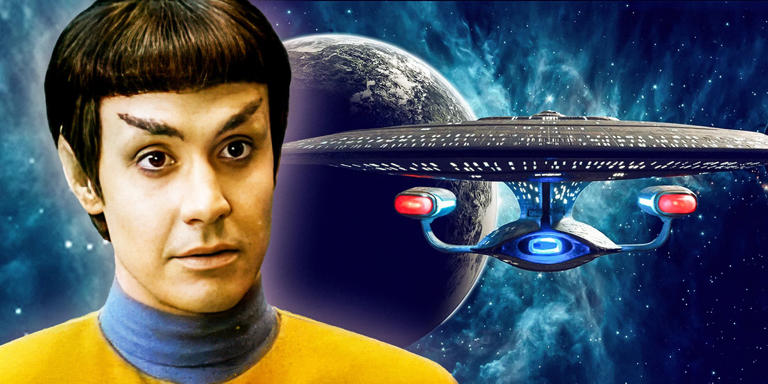

IMAGES
VIDEO
COMMENTS
"Prime Factors" is the tenth episode of Star Trek: Voyager. This television episode is a science fiction story, set in the 24th century of the Star Trek universe about a spacecraft stranded on the other side of the Galaxy that must make its way back to Earth. The ship is led by Captain Kathryn Janeway who must manage a ragtag crew of Starfleet, Maquis, and aliens; the show aired on UPN between ...
Prime Factors: Directed by Les Landau. With Kate Mulgrew, Robert Beltran, Roxann Dawson, Jennifer Lien. The crew encounters a hedonistic alien race with the ability to travel through the galaxy at will -- an ability that may be the key to Voyager's returning home.
The crew of Voyager discovers a planet that has the technology to send them more than halfway along their journey home. However, the planet's inhabitants are more than reluctant to share this technology with Voyager's crew, as doing so would violate one of the society's own prime directives. During a meal in the mess hall on the USS Voyager, the two crews, former Maquis and Starfleet, are ...
"Star Trek: Voyager" Prime Factors (TV Episode 1995) cast and crew credits, including actors, actresses, directors, writers and more. Menu. ... Essential Star Trek Voyager episodes a list of 47 titles created 08 Mar 2019 Classic Star Trek Episode Viewing Options a list of 306 titles ...
"Prime Factors," despite being just the ninth episode of Star Trek: Voyager, is perhaps the perfect example of the show's strengths and flaws all these years later—a dramatic, fascinating idea ...
Prime Factors. Captain Janeway and her crew of the starship Voyager have been lost in the Delta Quadrant of the Milky Way galaxy for four years. During their travels, they have encountered a variety of cultures, from the friendly to the hostile. But now, they have stumbled upon a planet which could provide them with a way home.
In-depth critical reviews of Star Trek and some other sci-fi series. Includes all episodes of Star Trek: The Original Series, The Animated Series, The Next Generation, Deep Space Nine, Voyager, Enterprise, Discovery, Picard, Lower Decks, Prodigy, and Strange New Worlds. Also, Star Wars, the new Battlestar Galactica, and The Orville.
Prime Factors Star Trek: Voyager. Series 1, episode 10 "Voyager encounters an alien race who are friendly but refuse to share technology that could get them 40,000 light years closer to home." Episode Guide - Quotes - Analysis - Notes. Episode Guide. In the mess hall B'Elanna checks out Ensign Murphy.
Prime Factors. Available on Paramount+, Prime Video, iTunes. S1 E10: Janeway may finally have an ally in the Sikarans, whose peaceful, advanced ways mirror those of Voyager. But when the Sikarans' own version of the Prime Directive forbids their sharing of technology that could get Voyager home quickly, unlikely allies in the crew plot to take ...
Janeway may finally have an ally in the Sikarans, whose peaceful, advanced ways mirror those of Voyager. But when the Sikarans' own version of the Pri…
Recap /. Star Trek Voyager S 1 E 9 "Prime Factors". The second big Hope Spot for the USS Voyager. Of course, this is still Season One. In the mess hall, Paris, Kim, Torres and Seska gossip and laugh about Kim's love life. Janeway notices and realizes that the two crews are finally starting to unite. But then she's called away to the bridge to ...
Prime Factors Episode Guide/Review by Charlynn Schmiedt. Season 1, Episode 9 Stardate 48642.5 (2371) Episode 9 of 168 Released in Star Trek: Voyager Episode 9 of 168 Produced in Star Trek: Voyager Production Number: 110 Original airdate: March 20, 1995.
Stardate: 48642.5. Harry Kim discovers advanced technology when a race of aliens known as the Sikarans offer shore leave to the crew of Voyager. This would send Voyager 40,000 light years closer to home, however, the Sikarians' "Canon of Laws" forbids them from sharing their technology with anyone.
Star Trek: Voyager follows the adventures of the Federation starship Voyager, which is under the command of Captain Kathryn Janeway.Voyager is in pursuit of a rebel Maquis ship in a dangerous part of the Alpha Quadrant when it is suddenly thrown 70,000 light years away to the Delta Quadrant. With much of her crew dead, Captain Janeway is forced to join forces with the Maquis to find a way back ...
The alien Sikarians, known for their great hospitality, invite the Voyager crew to their planet for a little rest and relaxation. Captain Janeway is on the verge of being smitten by the Sikarian leader when Ensign Kim tells the Captain that the aliens have the technology to transport up to 40,000 light years away - which represents about half the distance back to the Alpha quadrant.
The crew encounters a race of aliens who possess the technology to get them home.
Episode Guide for Star Trek: Voyager 1x10: Prime Factors. Episode summary, trailer and screencaps; guest stars and main cast list; and more.
This September and October, we're taking a look at the jam-packed 1994 to 1995 season of Star Trek, including Star Trek: Deep Space Nine and Star Trek: Voyager.Check back daily for the latest review. Prime Factors has some great ideas, but blunders awkwardly in the execution. In that respect, it genuinely feels like a first season episode of a new show in the same way that The Cloud did ...
When you multiply an episode of Star Trek by the "Prime Factors" of 70,000 light-years, you're probably going to end up with a decent episode. This week, the crew of the USS Voyager find themselves with a way home - but getting past a mirror version of the Prime Directive might prove impossible. In any case, Harry Kim should have ...
"Prime Factors" is the tenth episode of Star Trek: Voyager, in the first season of the series. Captain's log, stardate 48642.5 The crew is enjoying an evening on Sikaris. They are discovering, to their delight, that reports of this species' hospitality have not been exaggerated. The crew of encounter the Sikarians, a civilization who possess spatial trajector technology. A faction soon exists ...
Captain Janeway (Kate Mulgrew) and crew enjoy some downtime among a pleasure-centered race called the Sikarians, who prove wonderfully hospitable and sexy hosts. But they also have something Janeway could really use: the technology to travel 40,000 light years in an instant. Bafflingly, the Sikarians won't share it, and the captain insists on ...
Star Trek: Voyager's 20 best episodes bring out the best in Captain Kathryn Janeway, Seven of Nine, and the USS Voyager in the far-off Delta Quadrant. A Pair of Ferengi Negotiators, Arridor and Kol
Star Trek: Voyager made a mistake by not switching two important Neelix (Ethan Phillip) episodes in seasons 1 and 3. Neelix was Voyager 's Talaxian cook, morale officer, and unofficial ambassador ...
The crew encounters a race of hedonistic aliens who possess the technology to get them home; Janeway tries to convince the aliens to allow Voyager to …
First Appearance: "The Alternative Factor" (Season 1, Episode 27) ... as the ship plays a central role in a Shatner-authored novel and a Star Trek: Voyager short story. 4 Eymorg Starship
This episode is an away mission with the Prime Directive being a factor, which is a common enough Star Trek trope but not one that Star Trek: Discovery has relied on much. Was it also a fun change ...
Carlos Cisco, who co-wrote Star Trek: Discovery season 5, episode 5, "Mirrors" with Johanna Lee, discussed the Breen on The 7th Rule podcast.While discussing Discovery's new "jelly Breens", Carlos Cisco revealed that the Star Trek: Voyager villains, the Vidiians were considered as possible season 5 villains. Given that the Vidiians were seemingly cured of the Phage in Star Trek: Voyager season ...
Many incarnations of the USS Enterprise were completely destroyed through Star Trek, but some were simply decommissioned.The original Enterprise NX-01 commanded by Captain Jonathan Archer (Scott Bakula) survived its historic mission in Star Trek: Enterprise, eventually winding up on display at the Fleet Museum on Athan Prime.The USS Enterprise commanded by Captain Christopher Pike (Anson Mount ...
The Maquis changed Star Trek by subverting perceptions of Starfleet, forcing introspection on the human costs of Federation missions. Star Trek: Deep Space Nine set the stage for Voyager through ...
Before Voyager, Enberg's first appearance in the Star Trek franchise was on Star Trek: TNG, where he played the Vulcan Ensign Taurik in the season 7 episode "Lower Decks."The episode focused on a ...